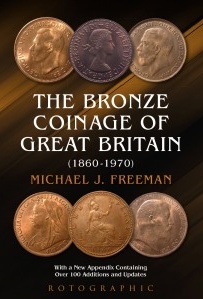
About UsThe Numismatic Bibliomania Society is a non-profit organization devoted to the study and enjoyment of numismatic literature. For more information please see our web site at coinbooks.org SubscriptionsThose wishing to become new E-Sylum subscribers (or wishing to Unsubscribe) can go to the following web page link MembershipThere is a membership application available on the web site Membership Application To join, print the application and return it with your check to the address printed on the application. Membership is only $20 to addresses in the U.S., $25 for First Class mail, and $30 elsewhere. For those without web access, write to: Terry White, Treasurer
AsylumFor Asylum mailing address changes and other membership questions, contact Terry at this email address: terrywhite5475@yahoo.com SubmissionsTo submit items for publication in The E-Sylum, just Reply to this message, or write to the Editor at this address: whomren@gmail.com BUY THE BOOK BEFORE THE COIN |
- WAYNE'S WORDS: THE E-SYLUM MAY 22, 2016
- HAPPY BIRTHDAY, ERIC P. NEWMAN
- KOLBE & FANNING'S MAY 2016 FIXED PRICE CATALOGUE
- NEW BOOK: THE BRONZE COINAGE OF GREAT BRITAIN
- BOOK REVIEW: MONEY CHANGES EVERYTHING
- THE EARLIEST AMERICAN NUMISMATIC BOOKS
- CONTEMPORARY REPORTS OF 1715 FLEET DISASTER
- MORE COIN AND MEDAL DIE TECHNOLOGY TERMS
- NEWMAN PORTAL ADDS MEDAL COLLECTORS OF AMERICA
- QUERY: THE NATIONAL COIN COLLECTORS ASSOCIATION
- AUTHOR SCHEIN WINS MEXICO'S PRADEAU AWARD
- NOTES FROM E-SYLUM READERS: MAY 22, 2016
- THE HISTORY OF DISNEY DOLLARS
- MORE ON DEALER NORMAN BROCK
- ARTHUR HENRY KRAUS (1880-1961)
- JAMES MEASE'S PICTURE OF PHILADELPHIA
- HOW GREEN IS THE U.S. CENT?
- AN 1809 HALF DOLLAR OVERSTRIKE ERROR
- C. H. SHINKLE'S U.S. COIN VALUES AND LISTS
- MEDALS WITH IMAGES OF COINING
- THE CASTLE SHANNON BANK ROBBERY
- THE LETTER AND COIN OF CHRISTOPHER COLUMBUS
- BOWERS HIGHLIGHTS POGUE IV LOTS
- REGULATED GOLD: STACKS'S BOWERS MAY 25, 2016 SALE
- STACKS'S BOWERS MAY 2016 RARITIES SALE SELECTIONS
- NUMISMATIC AUCTIONS SALE #59 CLOSES JUNE 20, 2016
- MEDALS SECRETLY AWARDED TO NAVY SEALS
- THE 2016 KATY RAILROAD COMMEMORATIVE MEDALS
- MIAMI OKLAHOMA 125TH ANNIVERSARY MEDAL
- SELECTED MEDALS OF BOGOMIL NIKOLOV
- MACRO & MICRO LENSES FOR SMARTPHONE CAMERAS
- FOCUS-STACKING PHOTOGRAPHIC TECHNIQUE
- ROYAL MINT EXPERIENCE CENTER OPENS
- BISHOP CAMERON'S COMMEMORATIVE ROUND POUND
- NEW-YORK HISTORICAL SOCIETY ANTI-SEMITISM EXHIBIT
- THE ZERO RUPEE ANTI-CORRUPTION NOTE
- LIBYAN FACTIONS TO ISSUE DUELING BANKNOTES
- A MONETARY HISTORY OF ISLAMIC SOCIETIES
- MISTAKE IN DNA HELIX ON TURKISH LIRA BANKNOTE
- COINS AMONG STUNNING FIND AT ISRAELI PORT
- COINAGE OF THE MONGOLS
- U.K. BARBER CALLS FOR TAX ON BEARDS
- FEATURED WEB PAGE: NEW JERSEY COPPERS
Click here to access the complete archive
To comment or submit articles, reply to whomren@gmail.com
WAYNE'S WORDS: THE E-SYLUM MAY 22, 2016
New subscribers this week include: Chris Lowman, courtesy of Duane Feisel, Tom Hagzan and T. Barth. Welcome aboard! We now have 1,974 subscribers.
This week we open with birthday wishes for Eric Newman, a new fixed price list from Kolbe & Fanning, one new book and one review.
Other topics this week include the earliest American numismatic books, the National Coin Collectors Association (NCCA), Disney Dollars, regulated gold, the medals of Bogomil Nikplov, the Royal Mint Experience and the designer of the last 'round pound'.
To learn more about coin dealers Norman Brock and A. H. Kraus, authors C. H. Shinkle and Allan Schein, heat treating, strain ageing, Grover Criswell's $5 bills, an 1809 overstruck half dollar, Castle Shanahan and Christopher Columbus' gold coin, read on. Have a great week, everyone!
Wayne Homren
Editor, The E-Sylum
HAPPY BIRTHDAY, ERIC P. NEWMAN


Eric P. Newman, circa 1931 and 2011
Dave Bowers writes:
It has been a pleasure to have known Eric ever since I was a teenager in the 1950s, to enlist his talents for various research projects, to visit with him in St. Louis and to have him visit me in New Hampshire. He is a numismatic treasure and a portal to enlightenment. Here's wishing him a happy 105th.
Ken Bressett writes:
Best Birthday Wishes Eric. You are my constant mentor and inspiration. The numismatic world would not be what it is today without your dedicated guidance and stimulation.
Roger W. Burdette writes:
Best birthday wishes to Eric P. Newman - a beacon of integrity and accomplishment in numismatics.
Beth Deisher writes:
Happy Birthday, Mr Newman! Thanks for sharing your knowledge and continuing to blaze the numismatic path for so many.
Jeff Garrett writes:
Happy birthday. I'm so glad you have been able to contribute to numismatics for so many years. We all wish you the best.
Jim Halperin writes:
Happy 105th birthday to my hero, friend and favorite lifelong polymath. When I grow up I want to be just like you!
Dick Johnson writes:
Eric: 60 Years. We have known each other for a long time. I remember I met you when I was a college student at Washington University in Saint Louis. You were kind and answered questions from a very inquisitive coin collector. You taught me a lot, perhaps I became a numismatist under your influence. In 1957 you lent me a rare coin to illustrate the cover of my Numismatic Directory, a university class project. I enjoyed our many discussions at the time on numismatics and literature of the field. We stayed in contact over the years. When I was editor at Coin World you were always available for counsel or information. I can recall many such events that brought our lives together, all pleasant memories. On your 105th birthday you can bask in the admiration of many numismatic friends. I am fortunate to be one of those friends. Enjoy.
Lou Jordan writes:
Dear Eric, Happy Birthday and thank you for all that you have done for numismatics.
George Kolbe writes:
"An investment in knowledge pays the best interest.” By Poor Richard's measure you are the richest man in the world. As to the world of numismatics, you have immeasurably enriched it by sharing that knowledge. To your friends and colleagues, you are an inspiration. Happy Birthday!
John Kraljevich writes:
Being a fan of the doggerel poem
and the author of dozens of tome
it's worth writing some rhymes
to mark Eric's times
To amuse him and the people who know him.
Into 2016 Newman forges
With his eyebrows still looking quite gorgeous
He has now seen much more
in a century and quarter score
than the reigns of the first three of the Georges
His books line all of our walls
Ensuring his place in Fame's halls
He shot and he scored
against old John J. Ford
When facing him down took some real honest to goodness fortitude.
Joel Orosz writes:
If we were living in Japan, Eric P. Newman would long ago have been declared a living national treasure. In numismatics, however, we've known for decades that Eric is our living national treasure, and we wish him a very happy 105th birthday!
Ute Wartenberg writes:
Best wishes on your birthday from your friends at the American Numismatic Society! You, your foundation and your work continue to influence and transform numismatics in the 21st century. You are a model for us all.
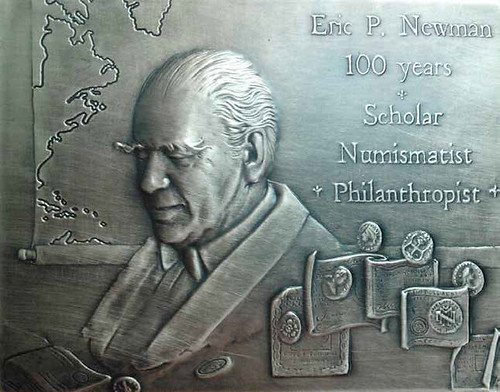
Medal for Eric P. Newman at 100
Andy Newman passed along this note from his father Eric:
In response to your request for a comment on the occasion of my reaching the advanced age of 105, I'm glad to take the opportunity to express my appreciation to the many wonderful people in the numismatic community who have made my life so exciting and fulfilling. As you know, I'm still working hard to advance numismatic research in every way I can. I will celebrate my birthday as I always do---with vichyssoise, barbecued ribs, and an ice cream sundae. I recommend it to everyone.
Naturally, I'm a fan of the Newman Numismatic Portal. The headline I see in my head is "105-YEAR-OLD MAN BUILDS 21ST CENTURY WEB SITE". Thanks so much for your vision, dedication and continual support for numismatics and numismatic research. Happy birthday! -Editor
To order a copy of Eric's amazing (mainly) numismatic biography Truth Seeker, see: http://coins.ha.com/itm/books/truth-seeker-the-life-of-eric-p-newmanres/i/960011799.s
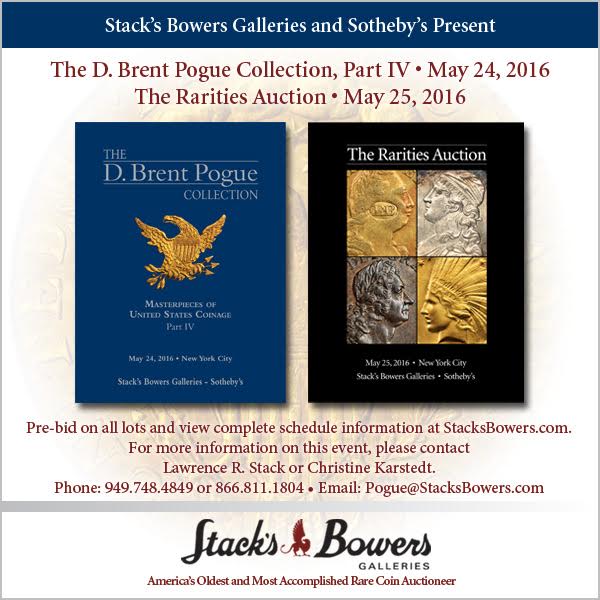
KOLBE & FANNING'S MAY 2016 FIXED PRICE CATALOGUE
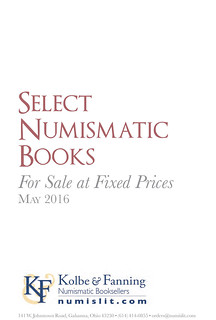 Kolbe & Fanning are pleased to announce the availability of their latest catalogue, the third in a series of fixed-price offerings of rare
and out-of-print numismatic books from around the world. Featuring works on ancient, medieval and modern topics, the 36-lot PDF catalogue aims to
include a wide variety of material.
Kolbe & Fanning are pleased to announce the availability of their latest catalogue, the third in a series of fixed-price offerings of rare
and out-of-print numismatic books from around the world. Featuring works on ancient, medieval and modern topics, the 36-lot PDF catalogue aims to
include a wide variety of material.
A few highlights from this May offering include:
- a complete set of Bahrfeldt's revision of Babelon on Roman Republican coins
- a beautiful complete copy of the first edition of James Mease's 1811 Picture of Philadelphia, including the earliest useful description of U.S. Mint operations
- the extremely important sale of Roman and Byzantine coins from the collection of Gustave, Vicomte de Ponton d'Amécourt (Rollin et Feuardent, 1887).
The catalogue is being published only in PDF form. No printed catalogue will be issued. It is being distributed first to those customers of ours who have signed up for our email list. You can sign up for our mailing list on our website at numislit.com. Kolbe & Fanning hope to issue similar fixed-price PDF catalogues throughout the upcoming year, so make sure you are among the first to know of them: most items offered are one of a kind.
Please email David Fanning at orders@numislit.com or call our office at (614) 414-0855 to purchase lots. We look forward to hearing from you.
To read the complete catalogue:
http://www.numislit.com/dl.php?file=/images/upload/may16fpl.pdf&type=pdf
To visit the Kolbe & Fanning web site:
www.numislit.com
NEW BOOK: THE BRONZE COINAGE OF GREAT BRITAIN
ISBN (printed version): 978-0-948964-84-8. Retail price: £14.00 (approx US$19.50).
ISBN (eBook version): TBC. Retail price: £6.00/ approx US$8.35.
Publication date: 16th May 2016 (printed), TBC (eBook).
Trouble finding a stockist: Call Rotographic direct on 020 308 69996
Probably the most important and most referenced book on British bronze coinage (the pennies, half pennies and farthings of 1860 – 1970). It's numbering system, which is often abbreviated simply with an ‘F' prefix, is used all over the world by sellers of British bronze coins, including all the major international auction houses and all reputable dealers, to distinguish one ‘Freeman' variety from other similar coins.
- 80% new images in the main section.
- New appendix with over 100 newly discovered coins.
- Larger B5 format.
This is a reprint of the most recent edition, in paper back form for the first time and with the added bonus of a new appendix containing over 100 coins that were not included in the last edition (the first ever update to the information for more than 30 years) and in the main section over 80% of the images have been replaced with better quality, new images. Where there is new information, the main text contains references to the new appendix. This new book is also larger than previous versions, in an attempt to further improve the quality of the images.
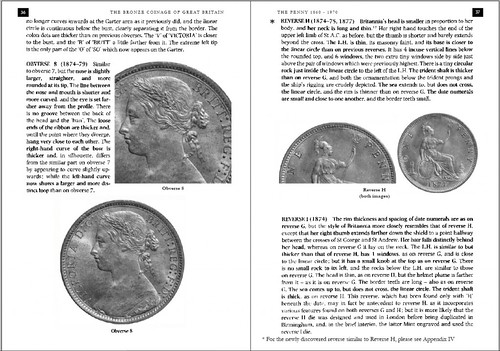
For more information, or to order, see:
M J Freeman, The Bronze Coinage
of Great Britain (www.rotographic.com/the-titles/british-coins/m-j-freeman-bronze-coinage-of-great-britain/)
To read the complete article, see:
British bronze coin
book is updated after more than 30 years
(www.coinworld.com/news/world-coins/2016/05/british-bronze-coin-book-is-updated-after-30-years.html)
BOOK REVIEW: MONEY CHANGES EVERYTHING
 Money Changes Everything: How Finance Made Civilization Possible
Money Changes Everything: How Finance Made Civilization Possible
by William Goetzmann,
Princeton, RRP£24.95/$35, 600 pages
A search on Amazon for the phrase “changed everything” reveals that everything changed everything. Among the book titles claiming that one particular slice of the universe had such an all-pervasive impact are works on — to name a few — Isaac Newton, air conditioning, Jesus, the Apple Macintosh, the Gatling gun, baby boomers and Minecraft.
Into this crowded field comes Money Changes Everything (subtitle: How Finance Made Civilization Possible) by Yale University finance professor William Goetzmann. Thankfully, Goetzmann does not appear to be motivated to live up to the hyperbolic title. This is a work of measured claims and meticulous research with a focus on finance as a “co-factor” in the advance of moral and material progress.
Societies have long faced a common set of problems, and technology develops to address them. To move things through space we devised wheelbarrows and aeroplanes; to move sound we invented telephony and MP3s. Goetzmann's insight is that finance, too, is a “movement” technology: we sometimes need to move money forwards (for example, to save for retirement) and sometimes backwards (to invest or consume). Like other technologies, finance is sometimes disruptive and has increased in complexity over time.
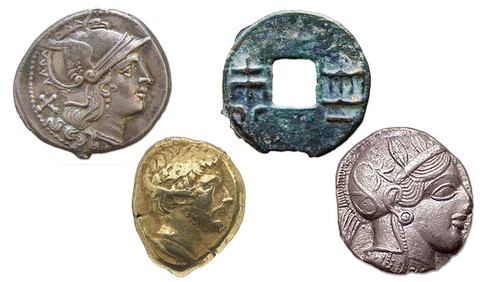
Coins, clockwise from top left: Rome (c.210BC); China (3rd century BC); Greece (c.449BC and 322BC)
Money Changes Everything is a global history of this technology, with a focus on the ancient near east, classical Greece and Rome, China through the Song dynasty, and medieval and modern Europe. Athenian democracy, the Roman empire, and the “Great Divergence” in which Europe pulled ahead of Asia in the 1700s are but a few examples of developments in which finance played a role in cascading change.
Most universities today pay lip service to “interdisciplinary” research but the forces keeping scholars in their silos are strong. True interdisciplinary scholarship is rare partly because it requires the researcher to speak multiple languages with native fluency. If one has grown up speaking economics, one can never speak native sociology, or vice versa.
Goetzmann's treatment of financial history is remarkable in its sure-footedness outside his home discipline: he seems equally at home in the modern glass structure of the Yale School of Management and the Yale Babylonia Collection a 10-minute walk away. The reader soon learns how he manages fluency of such breadth: as a young man Goetzmann participated in archaeology digs, studied art history and cavorted with specialists in cuneiform writing — in other words, he grew up multilingual. Money Changes Everything appears to tie together a lifetime of diverse interests.
Money Changes Everything is also a tactile and visual history. It is rich with illustrations, and often reported from ground level as Goetzmann travels to dusty European archives or to sites of historical financial significance. The author is at his best when his hands are dirty and there is something to see and touch. It is a pleasure to be in his company as he unfurls the 8-foot long charter of the Bazacle mill company of Toulouse (circa 1372), or describes the archeological remnants of financial panics in the Roman empire.
To read the complete article, see:
‘Money Changes Everything', by William Goetzmann
(www.ft.com/cms/s/0/015d965c-16ab-11e6-b197-a4af20d5575e.html)

THE EARLIEST AMERICAN NUMISMATIC BOOKS
David Fanning writes:
In reference to Dave Hirt's query about early American numismatic books, he asks if there are publications earlier than the 1740 work An Inquiry into the Nature and Uses of Money...
Yes and no. First, most of us do not consider works like this to be numismatic (Attinelli didn't either, for what it's worth). Generally speaking, books on financial history, monetary circulation and the economic ramifications of the issuance of paper money are held to be different than works written for collectors or scholars of coinage. It's a question of audience and intent: no one involved in the production of this 1740 title would have thought that it might be of interest to collectors of early American paper money.
Now of course such publications are held to be of some interest to collectors and scholars who value the context in which their colonial paper money was issued. For those collectors, I would recommend the four-volume set, Colonial Currency Reprints, edited by Andrew McFarland Davis (Boston: Prince Society, 1910-11). These volumes bring together and reprint 58 very rare early American publications issued between 1682 and 1751 on the subject of currency. The following is my usual commentary on this work:
An underappreciated masterpiece. Andrew McFarland Davis was a noted historian who specialized in the history of money in early American society. Conducting his research at a time when few appreciated the significance of his efforts, Davis published a number of monographs and articles on the subject, most of which remain significant in their particular area. His greatest contribution to historical research, however, is probably this extensive series of reprints. Davis eagerly sought out rare early American imprints discussing matters concerning paper money, many of which were only known by one or two copies. He reprinted these rare texts (generally pamphlets), thus making them available to scholars in his own time and ours.
His most valiant effort in this regard is Colonial Currency Reprints, a massive compendium of nearly 2000 pages encompassed in four volumes that reprints 58 of these extremely rare, yet important, records of our early financial history and experimentation with paper currency. The background is given quite well in the prospectus to the first volume:
“During the first half of the eighteenth century the American colonies of Great Britain emitted bills of public credit in denominational values, which first served as an auxiliary for the coin in circulation, and finally as a substitute for the coin which had been driven out of the country by these emissions. The experiment was started in Massachusetts Bay and gave rise to the publication of many tracts, some of which were devoted to an abstract discussion of the subject of the substitution of a paper currency for coin; some to the advocacy of private bills in place of public bills; some to the presentation of schemes for banks of issue the circulation of which should be based upon mortgages of lands; and some to the abuse of those who differed from the writers of the specific pamphlets on the topics under discussion.”
Only 250 sets were published. Clain-Stefanelli 13293. Davis 303. Grierson 219. McKerchar 2057.
Incidentally, Andrew McFarland Davis attributed the authorship of the 1740 work to Hugh Vans in the 1910 volume of the Proceedings of the Massachusetts Historical Society and it is included in his Colonial Currency Reprints.
David Gladfelter also points to Colonial Currency Reprints. He writes:
This anonymous work is reproduced in toto in Colonial Currency Reprints, 1682-1751, Andrew McFarland Davis, editor (Boston, The Prince Society, 1911, reprinted 1964) vol. 3, pages 365-474. Davis ascribes the work to one Hugh Vance, and states that “its apparent purpose was to meet the arguments put forth by (Dr. William) Douglass in his ‘Essay concerning silver and paper currencies,' etc.” Davis traces 8 copies of the Vance essay in various libraries, including the Library of Congress and the New York Public Library. The Douglass essay is also reproduced in Davis (vol, 3, pages 217-250).
Lou Jordan at the University of Notre Dame writes:
I had tracked down two versions of that work and forwarded them to Phil Mossman a few years back. Attached are the two PDFs.


George Kolbe adds:
Two particularly notable works of American numismatic interest published later in the eighteenth century also came to mind:
1) The first listing in Attinelli, namely “The Charter Laws and Catalogue of the Books of the Library Company of Philadelphia,” 1764, “Printed by B. Franklin and D. Hall,” (it features an account of “The valuable Collection of ancient Medals, in the Library”); and
2) A 1786 work relating to paper currency by the author of “Common Sense,” famous pamphleteer and patriot, Thomas Paine (1737–1809), entitled “Dissertations on Government, The Affairs of the Bank, and Paper-Money.”
It is interesting to note that Franklin and Paine were well acquainted with each other. It was my good fortune to have once sold an example of the former work. The closest I ever came to acquiring the latter was placing what I considered a strong (but, alas, unsuccessful) bid in a Swann Galleries sale a number of years ago.
David Fanning adds:
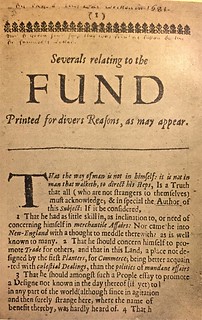 I do have a set of Davis reprints in my library and can confirm that the earliest work included therein is an eight-page pamphlet printed
in Boston in March 1681/2 titled "Severals Relating to the Fund," a commentary on a mutual fund organized by several Boston businessmen
that relied on "fund credit" instead of traditional money. The anonymous author has been identified by J. Hammond Trumbull as Rev. John
Woodbridge.
I do have a set of Davis reprints in my library and can confirm that the earliest work included therein is an eight-page pamphlet printed
in Boston in March 1681/2 titled "Severals Relating to the Fund," a commentary on a mutual fund organized by several Boston businessmen
that relied on "fund credit" instead of traditional money. The anonymous author has been identified by J. Hammond Trumbull as Rev. John
Woodbridge.
At the time of Davis's writing, the only known copy was in the Watkinson Library in Hartford. I do not know if this remains the only known copy, but coincidence has that I am friends with the Special Collections Librarian at the Watkinson and will discuss it with him. In the meantime, here is Davis's image of the first page of the pamphlet.
Ed Hohertz writes:
I searched the local library (Cleveland Public) and found that the "Inquiry Into The Nature And Uses Of Money" book is on microform. In addition, there is another related book of the same year by the same publisher.
A Discourse Concerning The Currencies Of The British Plantations In America
Especially With Regard To Their Paper Money: More Particularly, In Relation To The Province Of The Massachusetts-Bay, In New England
Douglass, William
Microform - 1740
To view the British Plantations in America entry, see: https://cpl.bibliocommons.com/item/show/2109004048_a_
discourse_concerning_the_currencies_of_the_
british_plantations_in_america
To view the Paper Money - Massachusetts entries, see: https://cpl.bibliocommons.com/search?q=Paper+
Money+--+Massachusetts.&t=subject
To read the earlier E-Sylum article, see:
Query: The Earliest American Numismatic Book
(www.coinbooks.org/esylum_v19n20a12.html)
CONTEMPORARY REPORTS OF 1715 FLEET DISASTER

Robert Hoge writes:
A friend sent me this interesting piece of information, which I thought E-Sylum readers might like to see too.
Recently we were contacted by Mr. Mark E. Mitchell who is a major dealer/appraiser of original historic newspapers who reported that he had found original issues of The Post Boy from London, England reporting on the loss of the 1715 Fleet. Mr. Mitchell was kind enough to send us several scans of the newspapers. Mr. Mitchell stated “these scarce newspapers are the closest any of us who are interested in this event can ever approach – one of the only ways we can “relive” what happened and the salvage efforts.” The documents forwarded to us by Mr. Mitchell are from Thursday, November 17 to Saturday, November 19 and from Tuesday, December 6 to Thursday, December 8, 1715.
We would like to thank Mr. Mitchell for sending us this fascinating archival information.
To read the complete article, see:
DATELINE: London, England –
Old Newspaper Reporting 1715 Disaster Found
(www.1715fleetsociety.com/dateline-london-england-old-newspaper-reporting-1715-disaster-found/)
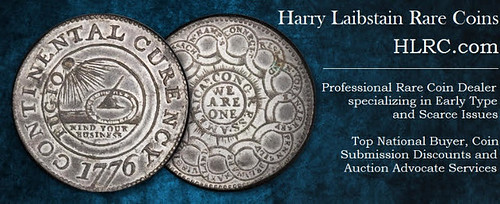
MORE COIN AND MEDAL DIE TECHNOLOGY TERMS
 Gary Beals wrote on extrusion dwell in last week's E-Sylum. There are other metalworking terms that apply to making coins and
medals. Few numismatists know of these concepts let alone the terms.
Gary Beals wrote on extrusion dwell in last week's E-Sylum. There are other metalworking terms that apply to making coins and
medals. Few numismatists know of these concepts let alone the terms.
Think of a mint as a large metalworking plant. The terms of this industry are a part of coin and medal manufacture. I have included relevant metalworking terms in my Encyclopedia of Coin and Medal Technology.
Many of these terms concern dies and their use. An important part of making dies is heat treating where dies have to be hardened and softened as needed. One of these terms is normalizing, returning a die to to a normal state after some heat treating process.
As an example, a private die maker told me the story of a client who ordered a Columbus medal die. He was in a hurry to obtain the die. Over the objection of the die maker he left with die in hand. It was wintertime and the die cracked in the cold temperature. He sheepishly returned an hour later, stating the die maker was right and to order a new one. The die had not been normalized, returned to room temperature.
Another metalworking term is strain ageing, failure in a die after a period of use. No one knows in advance when a die will break. This can happen with the first blow, or two hundred years later. Although in recent times the quality of steel is much better than years ago.
This is a major reason why it is often impractical to restrike from old dies. Age often makes old dies break because of strain ageing. Yet we have Papal dies still serviceable after two hundred years. The Paris Mint wisely struck a series of old dies side-by-side obverse and reverse on a strip of tin. It displayed the image on both dies without fear of breaking.
Many instances can be recalled of old dies breaking. Bob Bashlow acquired the Confederate Cent dies, took them to August Frank in Philadelphia and ordered restrikes. Of course, they broke. August Frank had to bind the broken parts together enough to withstand the pressure of making hubs. It worked and striking dies were made from the hubs after the diecrack on the surface of the hubs were chased off.
Pressmen learn to respect the dies they work with. For instance, it was observed dies were breaking on a Monday morning more so than other days of the week. The dies strain aged in two days over a weekend where they didn't overnight. If dies are to be stored knowledgeable pressmen will perform stress relieving on the dies before they go to the die vault.
Many of these terms are concerned with the interior of the die stock, which, of course, no one can observe. The crystalline structure of the iron effects hardness, tensile strength and ductility of iron the dies are made from.
While the artist and the numismatist are concerned with the image on dies, there is considerable technology to create and use dies correctly.
To read the earlier E-Sylum article, see:
BOOK REVIEW: ENCYCLOPEDIA OF COIN AND MEDAL TECHNOLOGY
(www.coinbooks.org/esylum_v19n20a05.html)
NEWMAN PORTAL ADDS MEDAL COLLECTORS OF AMERICA
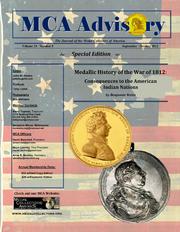 Courtesy of the Medal Collectors of America, the Newman Portal now includes back issues of the MCA Advisory through the year 2012.
The MCA Advisory features extensive original research, especially in the areas of Betts, Comitia Americana, Admiral Vernon, Indian Peace, and
modern art medals.
Courtesy of the Medal Collectors of America, the Newman Portal now includes back issues of the MCA Advisory through the year 2012.
The MCA Advisory features extensive original research, especially in the areas of Betts, Comitia Americana, Admiral Vernon, Indian Peace, and
modern art medals.
Writers include Dick Johnson, John Adams, Tony Lopez, and many other well-known names. Should these back issues whet the reader's appetite, a membership application for the MCA may be found at http://www.medalcollectors.org. The Newman Portal acknowledges Skyler Liechty, MCA President, for his assistance with this project.
Link to the Medal Collectors Advisory on the Newman Portal:
https://nnp.wustl.edu/library/publisherdetail/510765
QUERY: THE NATIONAL COIN COLLECTORS ASSOCIATION
 Recently a publication entitled The U.S. Coin Collector came across our desk. This run numbers eight issues between 1990 and 1991,
although one issue (no. 2) is missing here. Can an E-Sylum reader connect us with Bill Atkinson, the editor of this publication? This
organization was aimed specifically at collectors of U.S. coins, as opposed to the “literally unlimited” variety of other areas of numismatics.
Writers include Brad Karoleff, Bill Fivaz, Donn Pearlman, Joel Orosz, and others. The last issue in our run (November 1991, issue #8) ominously notes
a net loss of members, but there is otherwise no notice of cancellation.
Recently a publication entitled The U.S. Coin Collector came across our desk. This run numbers eight issues between 1990 and 1991,
although one issue (no. 2) is missing here. Can an E-Sylum reader connect us with Bill Atkinson, the editor of this publication? This
organization was aimed specifically at collectors of U.S. coins, as opposed to the “literally unlimited” variety of other areas of numismatics.
Writers include Brad Karoleff, Bill Fivaz, Donn Pearlman, Joel Orosz, and others. The last issue in our run (November 1991, issue #8) ominously notes
a net loss of members, but there is otherwise no notice of cancellation.

AUTHOR SCHEIN WINS MEXICO'S PRADEAU AWARD

From the award letter:
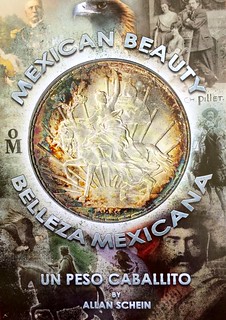 We are really happy to inform you that the “ALBERTO FRANCISCO PRADEAU” award has been bestowed on you in consideration to your excellent
book “Mexican Beauty, Un Peso Caballito”, the investigation, study and conclusions involved are considered of great merit for the understanding of
Mexican Numismatics.
We are really happy to inform you that the “ALBERTO FRANCISCO PRADEAU” award has been bestowed on you in consideration to your excellent
book “Mexican Beauty, Un Peso Caballito”, the investigation, study and conclusions involved are considered of great merit for the understanding of
Mexican Numismatics.
To read the earlier E-Sylum articles, see:
NEW BOOK: MEXICAN BEAUTY: MEXICO'S CABALLITO PESO
(www.coinbooks.org/esylum_v17n44a05.html)
BOOK REVIEW: MEXICAN BEAUTY: UN PESO CABALLITO
(www.coinbooks.org/esylum_v18n26a07.html)
NOTES FROM E-SYLUM READERS: MAY 22, 2016
"Mega Red" Spotted at Barnes and Noble

Gary Dunaier writes:
I saw the new 2017 "Mega Red" on the shelves at the Barnes and Noble in Union Square, New York City a couple of weeks ago. Interestingly, they also had a couple of copies of the 2016 Deluxe Edition (not yet Mega, but still of course red) next to it. So I decided to take a couple of pictures for comparison's sake.
Interesting to note that whereas the first edition had COINS in huge letters on the cover, the 2017 book de-emphasizes it in favor of its nickname, "MEGA RED 2017" being the most prominent text. Also, 2017 has "Kenneth Bressett, Senior Editor" (2016: "Senior Editor, Kenneth Bressett"), and adds the editorial functions to Q. David Bowers' and Jeff Garrett's names (2016 just had an umbrella "With"). It's also interesting to see the difference in the spine.
On a side note, will there be a new edition of A Guide Book of the Official Red Book of United States Coins? It's been 10 years since it came out, and I wouldn't mind seeing an updated edition.
More Grover Criswell Stories
Dave Bowers writes:
I could tell many stories about Grover—probably one of the most fun-loving and unconventional of all dealers. Once he had some pieces of paper money the size of a $5 bill printed, with on 25% of the surface of one side he reproduced the corner of a real current $5 bill. The rest of the face was blank. On the back was an ad for himself. He folded these into quarters so that only the $5 bill part was visible, then strew these on sidewalks and on a convention floor. They looked 100% like a real $5 bill that had been folded.
In another instance he had a submachine gun, and with someone else driving his convertible, on the Tamiami highway across the Everglades he peppered lots of roadside signs.
I won't mention the week that John J. Pittman went to Florida to spend a week with Grover!
To read the earlier E-Sylum article, see:
NOTES FROM E-SYLUM READERS: MAY 8, 2016 : Grover Criswell's Two-Dollar
Bills (www.coinbooks.org/esylum_v19n19a11.html)
Numimatic Kataloging 101
Alan Weinberg writes:
Saturday I received the Goldbergs' pre-Long Beach auction catalogue. One lot has a sentence which bears repeating in The E-Sylum. Lot 1211 1876 U.S. Mint C. Barber copy of the original A. Dupre Diplomatic medal described in part:
"Liberally [sic] as struck and definately [sic] the finest example the cataloguer ever encountered."
One hopes the cataloguer's numismatic expertise far surpasses his knowledge of the English language. But it doesn't as this moderately scarce Julian CM 15 always comes choice mint state, having been struck strictly for collectors.
Query: NGC Liberty Nickel Sample Slabs Sought
Burton Strauss III writes:
 If you have an NGC Liberty Nickel Sample Slab (Schwager# NGC-005-4-1) that you did not obtain in the last couple years off eBay, I would
like some information about it - I'm working on a study of the population of this unusual sample and maybe an article for The
Numismatist.
If you have an NGC Liberty Nickel Sample Slab (Schwager# NGC-005-4-1) that you did not obtain in the last couple years off eBay, I would
like some information about it - I'm working on a study of the population of this unusual sample and maybe an article for The
Numismatist.
(If you did buy from the eBay, I have the data from eBay, but would love to match people to sales)
Instead of a grade, these list "CIRC. 5C" and are "SAMPLE FA 00 NGC" which is also used for several dime samples.
What I'm interested in:
Cert#, e.g. 199998-025
Coin Date, e.g 1905
Label Color - known are "brown", "green" and "grey"
Where you obtained it
When you obtained it
Price paid if you care to disclose it
I know of the example from Sample Slabs.
If you have any information about their history or are willing to own up to having had them made, etc. I'd love to hear from you.
So far these are known with all dates from 1898 to 1912 (a 1913 being HIGHLY unlikely :-) and the coins are pretty uniformly G4 grade.
To read a related earlier E-Sylum article, see:
NEW BOOK: SAMPLE SLABS (www.coinbooks.org/esylum_v18n25a05.html)
Explaining Encapsulated Coins
Gary Beals of Segovia, Spain writes:
Explaining encapsulated coins is sometimes complicated here in Spain where they are a rarity. I told a friend recently that these items in slabs are absolutely authentic and precisely graded. The company doing this work is honor-bound and fully trustworthy. We put our complete confidence in these 3 or 4 major certifying firms just as we do, say, with Volkswagen. Well, wait a moment, Juan, let me re-phrase that.
 I think I owe the American Numismatic Association a slab-related favor. I renewed my membership for an additional three years last month
for $78, during a promotion that included being given a slabbed 2016 silver eagle one ounce ‘dollar.' The piece arrived here in central Spain about
15 days after it was mailed first class from Colorado. The $20 silver NCLT coin cost ANA $27.45 to mail, so more than half of my three year
membership has gone up in postage smoke. Clearly, ANA can afford to ship items but it is frustrating to see that the high cost of mailing (and UPS
and FedEx) from one continent to another is outrageous.
I think I owe the American Numismatic Association a slab-related favor. I renewed my membership for an additional three years last month
for $78, during a promotion that included being given a slabbed 2016 silver eagle one ounce ‘dollar.' The piece arrived here in central Spain about
15 days after it was mailed first class from Colorado. The $20 silver NCLT coin cost ANA $27.45 to mail, so more than half of my three year
membership has gone up in postage smoke. Clearly, ANA can afford to ship items but it is frustrating to see that the high cost of mailing (and UPS
and FedEx) from one continent to another is outrageous.
What is interesting is that ANA used NGC for encasing these pieces — not the American Numismatic Association Certification Service (now called just ANACS) to do this certifying. ANACS promotes itself as the oldest third party service in numismatics now, but obviously that long-ago divorce is final now. ANACS still uses its maiden name. Clearly, ANA clearly is dating others now. Poor ole ANACS has to tell people who ask, “Well, that was my married name. I just decided to keep it.”
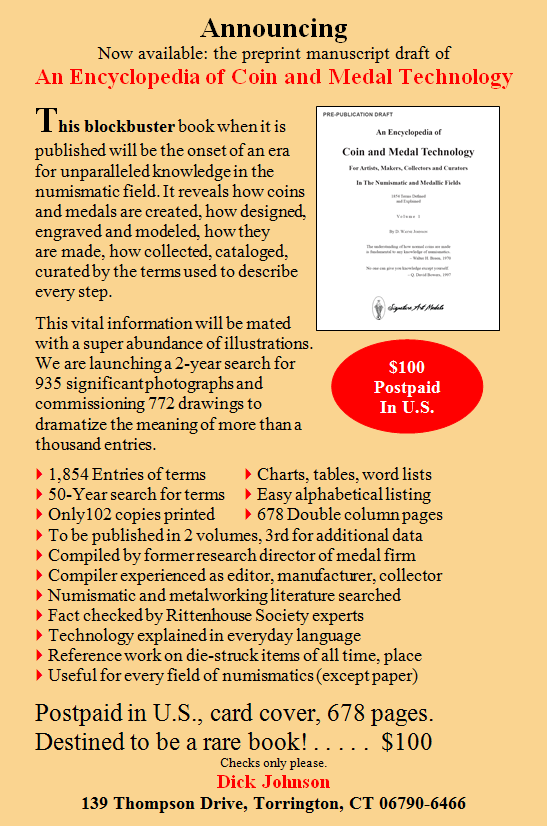
THE HISTORY OF DISNEY DOLLARS
Pete Smith writes:
 Attached is a link to a page from The Numismatist of November 2011 with an ad for a book on Disney Dollars by C. T. Rogers. The book
was only complete up to the time of publication.
Attached is a link to a page from The Numismatist of November 2011 with an ad for a book on Disney Dollars by C. T. Rogers. The book
was only complete up to the time of publication.
I met Rogers a few years back in Las Vegas at the convention for the Casino Chip and Gaming Tokens Collectors Club. Rogers is an expert in the gaming token field.
Phil Iversen writes:
A book covering the whole history of Disney Dollars was issued by Charles 'CT' Rogers who lived in California and also did another book on Casino Gaming Tokens. He was 74 years of age and passed away last October.
To view the ad in The Numismatist (ANA membership required), see:
https://reader.exacteditions.com/issues/47544/page/84
To read the earlier E-Sylum article, see:
DISNEY DOLLARS DISCONTINUED (www.coinbooks.org/esylum_v19n20a22.html)
MORE ON DEALER NORMAN BROCK
Regarding coin dealer Norman Brock, Rick Stroman writes:
I found nothing in Charles Davis' book American Numismatic Literature (1992). I did find a small tidbit in an ad of The January 1941 Numismatist pg 69 as follows: "BROCK'S ATTIC I am having a lot of fun writing my little monthly magazine of Coin and Stamp bargains. I am using this method to unload my entire stock. Write for my latest copy. I believe you will enjoy reading it."

I'm not able to answer David Hirt's questions about how long Norman Brock produced his periodical, but I do have some interesting Brock items to share. The first is his vendor stamp on a rare Whitman coin board for two-cent and nickel three-cent pieces from 1937. I also have several of his wooden nickels circa 1950 that include three different varieties. Both have the standard Indian head on their other sides.
 Norman Howard Brock was a very active and longtime member of the ANA. He was born in Wisconsin October 12, 1908 and was approved for
membership July 1, 1935 as Number 4789. He became active as a part time dealer in commemoratives when that series was hot 1935-36 and announced in
1937 that he was becoming a coin dealer full time and opening a store at 108 Broadway in San Antonio. Just three years later he announced his
retirement in another ad. No reason was given, but his other ads shortly before made reference to the collapse of commemorative prices. By 1943,
however, he was back in business at a different address, 317 Navarro. He remained there for ten years or more, before moving to two successive
addresses on Commerce Street sometime in the 1950s.
Norman Howard Brock was a very active and longtime member of the ANA. He was born in Wisconsin October 12, 1908 and was approved for
membership July 1, 1935 as Number 4789. He became active as a part time dealer in commemoratives when that series was hot 1935-36 and announced in
1937 that he was becoming a coin dealer full time and opening a store at 108 Broadway in San Antonio. Just three years later he announced his
retirement in another ad. No reason was given, but his other ads shortly before made reference to the collapse of commemorative prices. By 1943,
however, he was back in business at a different address, 317 Navarro. He remained there for ten years or more, before moving to two successive
addresses on Commerce Street sometime in the 1950s.
Brock appears to have been married twice, the first time in 1932 to Lorraine and then again in 1937 to Laurine. It's possible that these were the same person, since public records often misspell names, but in his 1937 ad announcing his full time dealer status he described himself as a newlywed. They had a son, Norman Howard Brock, Jr., in 1940.
Brock sponsored many new members over the years, and he was lauded by the ANA in 1991 as among its longest term members, this announcement coming just about the time he died. Among his new member sign-ups in 1938 was Maurice D. Scharlack, another San Antonio dealer and brother-in-law of coin board publisher Robert Ritterband (Lincoln Printing Company).
I found a cash donation to the ANA from Norman, Jr. in 2006, but I don't know whether he's an ANA member.
Finally, I came across a curious advertisement of his from the April 1945 issue of The Numismatist that was more in the nature of a declaration. I'd been saving it for my own Coin Board News, but it's suitable here, too. Brock chides himself and his fellow dealers for the good times they've enjoyed during the war years, while so many are suffering or sacrificing their lives.
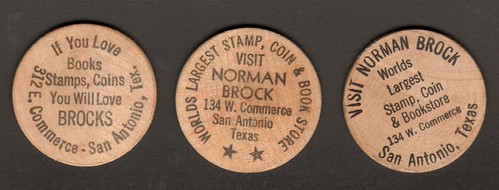
To read the earlier E-Sylum article, see:
NOTES FROM E-SYLUM READERS: MAY 15, 2016 : Query: How Long Was Brock's Attic
Issued? (www.coinbooks.org/esylum_v19n20a12.html)

ARTHUR HENRY KRAUS (1880-1961)
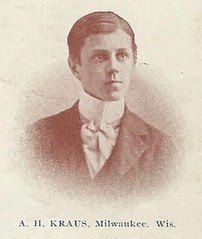 Arthur Henry Kraus (1880-1961), was born on 29 August 1880, in Wisconsin of German immigrants, Heinrich "Henry" W. Kraus (1843-),
and Bertha Kraus (1844-1920). He was the last of four children : Ida (1872-1963), Alma (1874-), and Edward (1874-). His father came to America in
1851 and worked as a harness maker. Edward worked with his father, but Arthur entered the field of printing.
Arthur Henry Kraus (1880-1961), was born on 29 August 1880, in Wisconsin of German immigrants, Heinrich "Henry" W. Kraus (1843-),
and Bertha Kraus (1844-1920). He was the last of four children : Ida (1872-1963), Alma (1874-), and Edward (1874-). His father came to America in
1851 and worked as a harness maker. Edward worked with his father, but Arthur entered the field of printing.
Kraus is interesting to the field of American numismatic history since he held a lifelong interest in collecting and selling coins and stamps and printed catalogues. Numismatic bibliophiles who come across these small printed catalogues might wonder who Arthur H. Kraus might be and how he factors into the American numismatic scene. This brief sketch was published to create a gateway to this publisher and dealer and expand our knowledge of his publications. He began around the time of B. Max Mehl and Tom Elder, who also both dealt in coins and published numismatic literature similar to Kraus. Yet Kraus remains obscure to us though he dealt in higher grade coins for over fifty years.
He ran various ads in medical journals and periodicals advertising publishing medical forms and seems to have depended on that line of business as his main source of income treating numismatics lifelong as a sideline. His name never appears in The Numismatist as an ANA member. The Milwaukee Numismatic Society was established on October 29, 1934. Yet we do not find Kraus as a member... He lived in Milwaukee his entire life...
Kraus was not only an advertising agent for a printer but eventually owned his own print house sometime in 1906. He also was a dealer as a side line printing his Official Premium Coin Catalogue and the Official Premium Coin Value Book beginning in 1906.
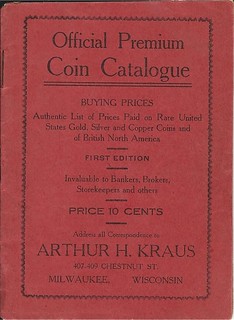

Kraus had strict policies regarding his mail order coin and stamp business. He only dealt in high grade specimens. For a small time dealer he preferred to deal in higher quality coins with good fixed premiums.
On 19 September 1906 he married Sophia Anna Henricksen (1886-1943) at Our Savior's Lutheran Church, Milwaukee, Wisconsin. In 1907, he became partners with his brother-in-law Alfred E. Laudon in the firm of Kraus-Laudon Company Printers, 407-409 Chestnut Street, Milwaukee, Wisconsin.

Kraus coin-buying ads from Argosy and Popular Science
He was an active coin dealer into his final years and published small ads in Numismatic Scrapbook most probably since he could not compete locally with Gimbel's Coin Department in Milwaukee. Curiously in those issues of Numismatic Scrapbook during this period that do not have his ads as Arthur Kraus, we do find ads for Badger Coin Service. Also, in The Numismatist, December 1957 we find him listed on page 1483 as a dealer where you can order a copy of Dick Yeoman's A Catalog of World Coins.
He died on August 26, 1961 at his home 1721 West Juneau Avenue, Milwaukee, Wisconsin. He is buried in Graceland Cemetery, Milwaukee, Wisconsin
To read the complete article, see:
KRAUS, ARTHUR HENRY
(https://sites.google.com/a/numismaticmall.com/www/numismaticmall-com/kraus-arthur-h?pli=1)
JAMES MEASE'S PICTURE OF PHILADELPHIA
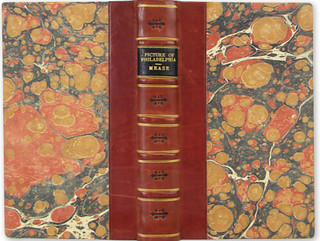 A foundational work of local history, generally regarded as including the first useful description of U.S. Mint operations.
A foundational work of local history, generally regarded as including the first useful description of U.S. Mint operations.
James Mease, M.D. (1771–1846) was a polymath who published on a number of different subjects, including medicine, geology and history. He was well known as the editor of the Domestic Encyclopedia (1803–04) and the Archives of Useful Knowledge (1811–12) and as the author of A Geological Account of the United States (1807).
In addition, he is considered to be the first writer to publish on the subject of U.S. numismatics. In a groundbreaking series of three articles, Mease examined U.S. medals and coins from the perspective of the numismatist, writing as a student in that discipline for others who shared this interest.
While a number of American publications of numismatic relevance antedate Mease's 1821 article “Description of Some of the Medals Struck in Relation to Important Events in North America,” these early publications either focus on foreign or ancient coins (the article by Rev. John Christopher Kunze, for instance) or were written for merchants, bankers, lawyers, politicians and other people who dealt with monetary issues on a daily basis. In his Picture of Philadelphia, he is more concerned with the Mint as a local establishment and public office than in discussing its products.
Mease begins his summary of the Mint and coinage on page 154, starting with an overview of the system existing before the establishment of a federal institution, then turning to the coinage itself, and its legal specifications regarding weight, fineness and design.
A brief but interesting discussion of technical matters follows, in which Mease admits that “at the first establishment of the mint, great difficulties and embarrassments were experienced from a variety of causes.” He continues by stating that “time has overcome them all, and it is understood, that in some respects the process of striking is more complete than in most other countries, England excepted.” He notes that “the mode of hardening the dies is peculiar to the mint, and is the discovery of the present assistant coiner, Mr. Eckfeldt.”
The assay commission, total mintage to date and officers are subsequently discussed. Mease's work is the earliest to give such a detailed description of the workings of the nascent Mint, and this is the first edition of that work (a second edition was published in 1824, with a supplemented edition published by Thomas Porter in 1831). Joel Orosz discusses the Picture of Philadelphia in the Fall 2001 issue of The Asylum. Scarce.
To read the complete catalogue:
http://www.numislit.com/dl.php?file=/images/upload/may16fpl.pdf&type=pdf
To visit the Kolbe & Fanning web site:
www.numislit.com
THE BOOK BAZARRE
HOW GREEN IS THE U.S. CENT?
 Most people know that pennies cost the government more to make than they're worth, even after the U.S. Mint switched to using mostly
zinc in 1982. They may not know that making all those pennies has a serious environmental impact, from raw ore, to smelter, to mint, and then to
banks before finally being dropped on the street or dumped into a coin kiosk or a fountain.
Most people know that pennies cost the government more to make than they're worth, even after the U.S. Mint switched to using mostly
zinc in 1982. They may not know that making all those pennies has a serious environmental impact, from raw ore, to smelter, to mint, and then to
banks before finally being dropped on the street or dumped into a coin kiosk or a fountain.
So with those costs also in mind, is it possible to make the penny greener?
Christina Cogdell, an associate professor of design at the University of California Davis, asks her undergraduate students to parse out each material comprising a particular product, all the way from raw material to burial. Two years ago, three of her students chose the penny. Christine Knobel, Nicole Tan and Darin Reyes spent a semester analyzing the information they could find to make an assessment of the penny's ecological footprint. Their conclusion was the true cost of making a penny adds up to much more than 1.43 cents, or what the Mint reports it cost to produce a one-cent coin last year, though they were not able to individually parse out the incremental cost per coin of mining, smelting, minting and trucking the coins—all energy intensive processes. “We were surprised about the lack of information,” said Knobel. “We weren't able to find out anything more detailed.”
To be fair, the current production cost is down from the 1.66 cents it cost in 2014, and the continuation of a years-long trend and efforts by the Mint to increase efficiency as well as sustainability.
The Mint itself has tried to find out if making coins, including the penny, out of different metals might make them cheaper (and maybe greener) to produce, but it concluded, that for the penny, “there are no alternative metal compositions that reduce the manufacturing unit cost of the penny below its face value,” according to a 2014 report to Congress.
Each Mint facility conducts monthly environmental compliance audits and aims to reduce direct emissions by 33 percent by 2020. The Denver Mint is already 100 percent wind-powered, and the power-hungry stamping presses now have a sleep mode to reduce power consumption when not in use.
Copper mines, located mostly in Arizona, tend to be of the open-pit variety, which allows more substances to be released. Zinc mines can be open or closed; Red Dog Mine, in Alaska and the country's largest, is an open pit mine, and has been embroiled for years in water pollution and toxic waste fights. Much of the rest of the country's zinc is produced in Tennessee, whose emissions are limited by virtue of being underground.
Here's an idea of the torture zinc must go through before it is pure enough to be lacquered with copper and punched into a coin. Mining involves blasting and chipping zinc-containing sphalerite ores away from the surrounding limestone, then crushing and processing the ores in chemical baths that separate the zinc from other minerals. At the smelter, raw zinc is roasted to remove sulfides, then sent through a leaching and purification process.
The main byproducts of this process include sulfuric acid, which is collected for resale, and sulfur dioxide, which can cause acute respiratory distress. Mercury is another impurity removed during this process. Nyrstar's operations, both at the mining and refining levels, are well under state and federal limits set for releases of other toxins including cadmium and lead, though the company was fined once in 2009 for a release of cadmium into the Cumberland River in excess of permitted release limits.
“After doing the research, it became clear that the penny isn't needed,” she said. “If the Mint is trying to reduce energy, why not reduce it by a whole coin? That would be a huge step in the right direction. I don't think it's going to be that big of a deal.”
To read the complete article, see:
How Much Does it Really Cost (the Planet) to
Make a Penny? (www.smithsonianmag.com/science-nature/penny-environmental-disaster-180959032/)
AN 1809 HALF DOLLAR OVERSTRIKE ERROR
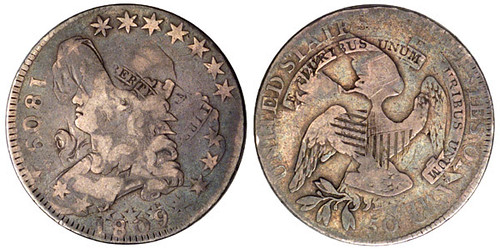
I've never seen this mint error before and I suspect many readers haven't. It is simply one of the most visually impressive U.S. errors I've ever seen in 58 yrs collecting. It may interest E-Sylum readers.
Gad, two 1809 dates! I wonder who owns it?
Each week, I try to "headline" the JR Newsletter with a pretty, interesting, or pretty AND interesting coin. I decided to search through the Russ Logan collection (as sold by Bowers and Merena in 2002) for a neat coin. That's when I saw the amazing 1809 as lot 2237. Bowers and Merena cataloged the item (which appears to have sold for $13,000) as follows:
Double Struck with 90° rotation between impressions. Natural deep gray surfaces with steel blue toning. The devices are lighter gray. We have examined this double struck half dollar very carefully, and have not been able to conclude which of the two strikes came first. Virtually all of the design from each strike is visible on both obverse and reverse, with much of this detail overlapping from one strike to the next.
The two strikes appear exactly identical with regard to die characteristics with one exception. On one of the two strikes, the digit 8 has a very small lump attached to the upper edge of the cross-stroke, inside the upper loop. The other strike does not show this feature. This may be simply an additional artifact from the opposite strike.
Purchased April 14, 1992 from Stewart Witham.
Those who are interested in seeing the Logan collection online can go to http://rob.com/russ/collection/index.html .
The 1809 catalog description is found through this link: http://rob.com/russ/collection/2237.html .
Once at the Logan collection website, clicking on the camera icon next to each coin's brief description will open a new window with images and the catalog description. I have found this website to be an invaluable research and learning tool.
To read the complete JR Newsletter issue, see:
JR Newsletter: 15 May 2016 (293)
(http://us11.campaign-archive2.com/?u=74a0e3c37d154d935bdeb2daf&id=ed071bf0b7&e=9bc1157359)
C. H. SHINKLE'S U.S. COIN VALUES AND LISTS
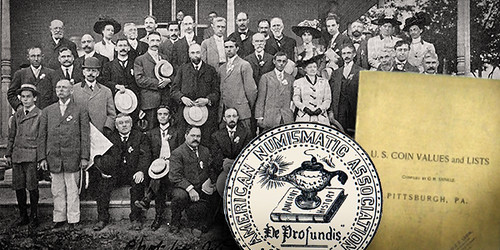
I was just reading about the 1909 ANA Convention in Montreal and taking a headcount of all of those who attended.
One of the attendees was Chicago coin dealer Theophile Leon.
Leon operated the Chicago Coin Company (not to be confused by today's iteration of the Chicago Coin Company of 6455 W. Archer Ave., the junior dealership was founded in 1955). Others in attendance were E. H. Adams, the Chapman brothers, Thomas Elder, J. M. Henderson, Frank C. Higgins, H.O. Granberg, Elmer Sears, Howland Wood and Farran Zerbe.
I mention him because it was probably an advertisement placed in the back pages of the August 1909 issue that inspired Leon to purchase a price guide by Pittsburgh, Pennsylvania-based auction researcher C. H. Shinkle entitled U.S. Coin Values and Lists, 1909 Edition (the second of three, and an update of his 1905 edition).
Shinkle's ad described the book this way:
“Exhibits of prices paid for nearly every U.S. Coin at Auction Sales during 1907-1909. Auction prices are very rarely less than the coins are worth”.
The 20-page booklet contains lists of rare U.S. Coins, Private Gold Issues (including fractional gold pieces known at the time), $50 gold coins, U.S. pattern cents and other information. The cost was $1.00
I know that Leon purchased the book because Kolbe & Fanning are currently offering his copy for sale on numislit.com for the very reasonable price of $35. I'm tempted to buy it and may do just that if one of our readers doesn't pick it up first!
Numismatics is a hobby of connections – of people, personalities and coins.
Oftentimes, taking time to read about yesterday's hobby can be every bit as enriching and exciting as picking up a new coin for the collection.
To read the complete article, see:
Vintage
Numismatic Books – U.S. Coin Values and Lists by C. H. Shinkle
(www.coinweek.com/expert-columns/charles-morgan/vintage-numismatic-books-u-s-coin-values-lists-c-h-shinkle/)

MEDALS WITH IMAGES OF COINING
 One of the challenges facing any numismatist is to find an area of interest that will hold their attention over a sustained period of time.
This can be even tougher for the professionals among us, as what had been a hobby has become work. Recapturing the ‘hobby' aspect of collecting has
proven helpful to me for ‘work' as well.
One of the challenges facing any numismatist is to find an area of interest that will hold their attention over a sustained period of time.
This can be even tougher for the professionals among us, as what had been a hobby has become work. Recapturing the ‘hobby' aspect of collecting has
proven helpful to me for ‘work' as well.
About ten years ago, I acquired a Mexican 1 onza piece. These one ounce silver bullion coins feature a large screw press as its central
design.
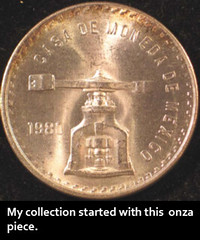 This extremely common issue set me to wondering about what other pieces might have coining presses on them. With that, a topical collection
was born. Over the past decade, I've been fortunate to find a sizable number of pieces. While there have been other coins along with some tokens,
banknotes, postcards and even a stamp, the majority of pieces I've found that really fit in are medals.
This extremely common issue set me to wondering about what other pieces might have coining presses on them. With that, a topical collection
was born. Over the past decade, I've been fortunate to find a sizable number of pieces. While there have been other coins along with some tokens,
banknotes, postcards and even a stamp, the majority of pieces I've found that really fit in are medals.
It's a fringe benefit from work that I'm often at major conventions where I get the chance to wander the bourse floor. I've also found quite a few foreign medals from international sellers on eBay. My buying experience on this venue with this material has been almost entirely positive. Most of the sellers I've dealt with have had spotless feedback and tend to be medal dealers.
 There are some reference books that cover medals in general, but I've yet to find works that cover this topic specifically. There's some
charm involved with this, as many of my new purchases represent pieces I had no idea existed until I had a chance to buy them. There's a degree of
excitement when I hit a new bourse with no idea of what I might find. I've had multiple opportunities to share this particular interest with other
collectors, with both club presentations, and show exhibits. Each time, the material has appeared to be well received. One day when my collection
feels more complete, I'll likely write a book on the subject, but that's dangerously close to turning what I do for fun into work.
There are some reference books that cover medals in general, but I've yet to find works that cover this topic specifically. There's some
charm involved with this, as many of my new purchases represent pieces I had no idea existed until I had a chance to buy them. There's a degree of
excitement when I hit a new bourse with no idea of what I might find. I've had multiple opportunities to share this particular interest with other
collectors, with both club presentations, and show exhibits. Each time, the material has appeared to be well received. One day when my collection
feels more complete, I'll likely write a book on the subject, but that's dangerously close to turning what I do for fun into work.
For more information on the Cincinnati Numismatic Association, see:
CINCINNATI NUMISMATIC ASSOCIATION (https://cincycoinclub.org/)
THE CASTLE SHANNON BANK ROBBERY

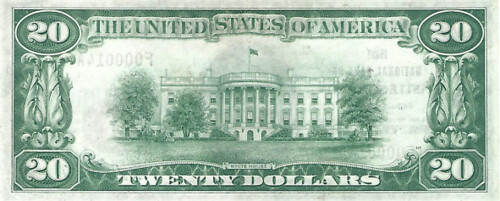
On May 14, 1917, one of the most notorious crimes in Pennsylvania's history occurred in a small, inconspicuous town on the west side of the state. It was an otherwise run-of- the- mill day in Castle Shannon when five Russian immigrants entered the town's First National Bank and began demanding money. A hold-up and shoot-down ensued, and after multiple shots were fired and cashiers and crooks alike fell, the remaining gunmen stormed into the cage to loot the bank in over $18,000 in coins and cash. Of that, only over $8000 has been accounted for to this day.
This robbery and the events that occurred on that spring afternoon would go down in Pennsylvania history as one of the most notorious crimes ever committed.
Twelve years after that murderous day in Castle Shannon, after the infamous Stock Market Crash of 1929 and well into the Great Depression, the U.S. Treasury called in all currency to be accounted. They took a census, and while most banks brought in one to two thousand dollars, a mere $250 in Castle Shannon notes was accounted for - $250 out of the possible $108,000. Everybody was looking for the Castle Shannon money, but nobody was finding it. All US banks closed in 1933; in that year all banks came under the Federal Reserve Bank System we know today.
Tracing the Note
Although the entire history of Ray's Castle Shannon $20 bank note can't be traced, after all, there wasn't a note tracking system until
recent years, Ray does know a bit about its history. “I know it was in Florida for some time,” he says. A man at Iron City Coins named Jay,
a dealer, displayed the note at a Pennsylvania Association of Numismatists (PAN) show. Ray knew then that, being from Castle Shannon, he
had to get his hands on this note, and he recognized that notes from Castle Shannon were rare in general. “So I traded some coins and
purchased it for $10,000,” says Ray. This purchase was offered in May of 2013.
The First National Bank of Castle Shannon printed $108,550 dollars worth of national currency, which is a small output to begin with. Because of this, National bank notes from Castle Shannon in general are scarce. The bank opened in 1908 and ceased the printing of notes in 1932 – a small 24-year printing period.
In 1902, The First National Bank of Castle Shannon printed 1,047 sheets of $20 blue seal national bank notes adorning the portrait of United States' Treasury Secretary Hugh McCulloch with the blue seal indicating a limited note form. Twenty-seven years later, another printing of Castle Shannon $20 notes began, but this time, only 51 sheets were printed. By nature, $20 notes are three times more rare over smaller bills, so when Ray purchased the extremely uncommon 1929 note, he knew it was something extraordinary.
“It's the 14th note,” he says. Notes were printed on sheets of 6 per, so Ray owns the second note on the third sheet of printed $20 notes. Rare doesn't even begin to describe it. “I have people offering up to $15,000,” he says.
On that “note”, the elusiveness surrounding the Castle Shannon Bank Robbery coupled with the uniqueness of Castle Shannon notes in general makes Ray's $20 piece one of the most collectable pieces in Allegheny County, if not in the entire state of Pennsylvania.
The people who colonized Southwestern Pennsylvania were mostly of Scotch-Irish decent and the area that became Castle Shannon was no exception. Land patents to established boundaries were first issued in 1784 and it was stylish to name ones property. Some of these patent names showed religious inclination, as in "Jerusalem" and "Gilead"; the others incorporated the owners name as in "Cool Castle" and Hulse's Walk," David Strawbridge commemorated his Irish roots by naming his farm "Castle Shanahan."
David Strawbridge's farm was mostly along what is currently Poplar Avenue to Castle Shannon Boulevard, then up to Shady Run. He died in 1792, with no male heirs, so his property was left to his only unmarried daughter, Jean. She sold the parcels of the original patent to her sister's families.
At first this area was claimed by both Pennsylvania and Virginia, so each of the founders established their claim by petition whichever state was more convenient. The greater area became known as Lower St. Clair of Washington County, and then was repositioned into Allegheny County in 1797. The local citizens petitioned for years to break away from Lower St. Clair and in 1844 Baldwin Township was formed. Baldwin contained most of the South Hills. With different areas developing their own characteristics by the 1870's this area had become know as the Village of Castle Shannon.
To read the complete article, see:
A Proud and Storied History
(http://borough.castle-shannon.pa.us/History.htm)
For more information on the Pennsylvania Association of Numismatists, see:
http://pancoins.org/
THE BOOK BAZARRE
THE LETTER AND COIN OF CHRISTOPHER COLUMBUS
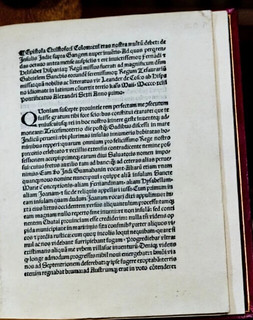 A stolen copy of a rare 15th-century letter written by Christopher Columbus was repatriated to Italy this week and unveiled in a ceremony
in Rome that was attended by U.S Ambassador John Phillips and Italian Culture Minister Enrico Franceschini.
A stolen copy of a rare 15th-century letter written by Christopher Columbus was repatriated to Italy this week and unveiled in a ceremony
in Rome that was attended by U.S Ambassador John Phillips and Italian Culture Minister Enrico Franceschini.
On his return voyage from the Caribbean in 1493, the Genoese explorer penned a letter to his Spanish sponsors, detailing his discoveries. Columbus, at the time, was still convinced that he had found "the Indies" and realms near "Cathay," or China. The original document has been lost, but a Latin translation was reprinted and spread around Europe. This specific version is known as the "Plannck II" letter, named after the Rome-based printer who reproduced it in 1493.
This particular version of the letter had been housed in a library in Florence, Italy, before it was apparently stolen and replaced with a forgery in the 1950s. It resurfaced in the possession of a Swiss collector in 1990, who sold it to an American rare-books collector. It was eventually donated to the U.S. Library of Congress in 2004.
Only in 2012 did the Carabinieri, or Italian military police, realize that the letter in Florence was a forgery. A subsequent American-Italian investigation led to the genuine document's handover this week.
The irony of the missive finally making its way back from the New World, centuries after the first journey, was not lost on Rome.
"It is interesting how 500 years after the letter was written it has made the same trip back and forth from America," Franceschini, the Italian culture minister, said.
Robert writes:
Few people probably realize the numismatic connection that Columbus included in his account for the monarchs. I published this, in a fairly obscure Canadian journal some years ago, citing how he referred to a gold portrait coin of "their majesties" Ferdinand and Isabella (you know, I don't quite understand why all subsequent generations seem to use this nickname for the famous queen, whose name was actually Elizabeth!) to show a native chief who his new masters now were!
I'm kind of enthused about this find because I have studied the Columbus materials in the past, and was recently able to acquire one of the actual sort of gold coins to which Columbus alluded! (A castellano of the Reyes Catholicos, from the mint of Sevilla!)
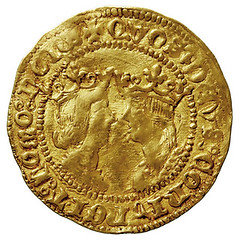

To read the complete article, see:
Here's the 523-year-old letter Christopher Columbus wrote after reaching the Americas
(/www.washingtonpost.com/news/worldviews/wp/2016/05/18/heres-the-523-year-old-letter-christopher-columbus-wrote-after-discovering-the-americas/)
To read the complete article, see:
Historic 1493 letter from
Columbus is returned to Italy (www.chicagotribune.com/news/nationworld/ct-christopher-columbus-letter-20160518-story.html)
BOWERS HIGHLIGHTS POGUE IV LOTS
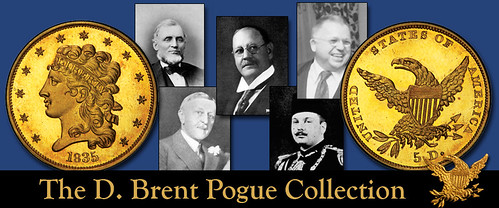
As I write these words, our sale of the D. Brent Pogue Collection Part IV at Sotheby's international headquarters in New York City is coming up quickly. I hope to see you in person as a bidder, buyer, or interested observer. Or I and the Stack's Bowers Galleries staff will "see you" as you watch in real time on the Internet. Either way, you will be part of numismatic history as it is being made—an unforgettable experience!
In recent weeks in my commentaries I have been showcasing some of the 63 coins in our sale on Tuesday. I am not sure, but this may be the second smallest coin-count auction sale for which we have issued a regular catalog. The other was in 2002 when we featured just one coin—a 1933 double eagle—which crossed the auction block for $7,590,020—setting an all-time record for a gold coin, which still stands. But, stay tuned—the Pogue 1822 $5, the only such coin in private hands, will likely eclipse it. As you probably know, there are only three 1822 half eagles in existence—the other two in the National Numismatic Collection in the Smithsonian. As to the 1933 $20 the Smithsonian has two, the Treasury has 10, and several others are in private hands (Ted Naftzger once had four), but due to restrictions they are not likely to be sold soon.
The 1822 half eagle will give the buyer a unique status—the only private person in the world to own one. The last time an 1822 crossed the block was in 1982 when I cataloged this coin and the Pogue family bought it. Now, 34 years later—more than a generation—there is another opportunity.
The other 62 coins are each notable. Our catalog is unequalled in terms of a combination of ultra-high grades and rarity! Sort of like selling a room full of Rembrandts!
That brings me to this week's showcase coin—not a multi-million dollar rarity, but a beautiful coin with no equal. It is the 1835 half eagle, McCloskey-5, nearly Rarity-8 as a Proof, graded Proof-67 DCAM by PCGS. It is far and away the finest example in existence!
Years ago David W. Akers cataloged this coin and stated in part:
"Gem Proof. A superb specimen. The beauty and outstanding quality of this Proof simply cannot be overstated. This coin is absolutely fully struck with deep mirror fields, a sharp square edge, and the most gorgeous rich yellow and copper hued gold color imaginable." Akers went on to describe die characteristics and a tiny lint mark.
He then concluded: "Anyone who loves superb coins, especially superb early Proof coins, is in for a real treat when they view this coin and the 1833 and 1836 half eagles, three very special coins which will be long remembered in the annals of American numismatic auctions."
The buyer of this 1835 half eagle will join an illustrious roster, a veritable Who's Who in American Numismatics, except I have to add, "plus the King of Egypt." I could write essays on most of the people on the following list:
Provenance: George F. Seavey Collection, before 1864; Lorin G. Parmelee Collection, by sale, en bloc, 1873; Lorin G. Parmelee Collection; New York Coin and Stamp Company's (H.P. Smith and David Proskey) sale of the Lorin G. Parmelee Collection, June 1890, lot 1021; William H. Woodin Collection; Waldo Newcomer Collection, by sale, early 1920s; B. Max Mehl, by sale, 1931; Edward Howland Robinson Green Collection, by sale, 1932; Edward Howland Robinson Green Estate, 1936; Stack's, by sale, via Chase Manhattan Bank, 1943; King Farouk of Egypt Collection, via Hans M.F. Schulman; Sotheby's sale of the Palace Collections of Egypt, February 1954, lot 248; John J. Pittman Collection; David Akers Numismatics, Inc.'s sale of the John Jay Pittman Collection, Part I, October 1997, lot 937; Gold Rush Collection; Heritage's sale of January 2005, lot 30050; Spectrum Numismatics, by sale, August 2006.
Wow!
I invite you to purchase the two books we've published about the D. Brent Pogue Collection. Satisfaction is guaranteed, or your money back. PLUS, if requested, I will personally autograph your copy.
Treasures from the D. Brent Pogue Rare Coin Cabinet, by Q. David Bowers. 208 pages, color illustrated, quality hardbound. This tells the stories of 100 special coins from the collection. $39.95 plus shipping. Personally autographed by Dave on request.
The 1822 Gold Half Eagle: Story of a Rarity, by Q. David Bowers. 128 pages, color illustrated, quality hardbound. $39.95 plus shipping. This also contains a wealth of information about other coins, people, places, and things—a "you are there" experience. Personally autographed by Dave on request.
For more information or to order visit http://media.stacksbowers.com/poguecollection/pogue-the-books.html .
To read the complete article, see:
ALMOST THERE! See you on May 24th at Sotheby's!
(www.stacksbowers.com/News/Pages/Blogs.aspx?ArticleID=2099)
THE BOOK BAZARRE
REGULATED GOLD: STACKS'S BOWERS MAY 25, 2016 SALE
Lot 3: Ephraim Brasher regulated English 1774 guinea

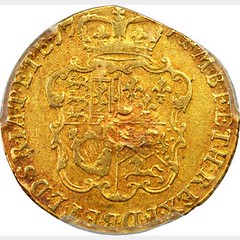
(ca. 1784) Ephraim Brasher regulated English 1774 guinea ($4 2/3). AU-50 (PCGS). Countermarked once, single diagonal clip. No plug.
The oval EB mark is identical to all those offered herein, the same mark seen on the famous Lima and New York style Brasher doubloons. Brasher applied his mark as close to center as possible; when he followed John Burger, who tended to place his mark on a portrait's eye, the Brasher mark tends to be nearer the base of the bust. Brasher marks are often seen lightly doubled. On this specimen, the mark was first applied with the punch face not perfectly parallel to the host, leaving just the upper right corner of the errant first impression above B. The dominant impression was placed heavily and neatly, offering a superb and intact strike of the most famous touchmark in American numismatics.
Brasher seems to have accomplished a lot more reduction of full-weight coins than plugging of underweight specimens. His clips tended to be straight across the lower right or lower left of specimens he regulated, thus making the clipping obvious rather than the well-hidden circumferential clipping of those with criminal intent. The 1784 New York standard that Brasher worked under required an acceptable guinea to weigh 5 pennyweight, 6 grains, equal to 126 grains or about 8.16 grams. The weight of this coin was not measured by PCGS and is thus not available at the time of cataloguing.
Several other Brasher guineas are known. Another bearing the date 1774, like this specimen, realized $43,700 in the Eliasberg world gold sale over a decade ago. Three other Brasher guineas were included in the Garrett collection, all sold in the 1981 Garrett IV auction. The only one of this George III type had its date clipped away; the other two were a 1734 with the young bust of George II and a 1749 showing George II's older portrait. The 1749 George II guinea from Garrett, marked by both Brasher and Burger, re-appeared in the 2010 Roehrs sale, selling for $46,000.
To read the complete lot description, see:
(ca. 1784) Ephraim Brasher regulated English 1774 guinea ($4 2/3).
(https://auctions.stacksbowers.com/lots/view/3-4IFCK)
Lot 5: Ephraim Brasher and John Burger regulated Brazilian 1745 Bahia 6400 reis
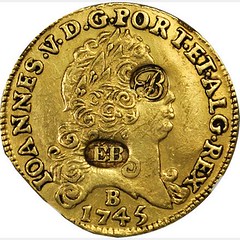

(ca. 1784) Ephraim Brasher and John Burger regulated Brazilian 1745 Bahia 6400 reis or half Joe ($8). 13.928 grams. AU-50 (NGC). Countermarked twice, single diagonal clip. No plug.
A superb early half Joe, struck in the Brazilian city of Bahia in 1745 and already four decades old by the time it reached the liberated post-Revolutionary city of New York. The large round mark of John Burger is ideally struck and perfectly situated at its typical location, on the eye of the portrait, while the classic oval mark of Ephraim Brasher is equally boldly struck lower on the portrait. No plug is seen beneath either mark, suggesting than this coin remained essentially unclipped between 1745 and 1784. Burger took just a light diagonal clip, affecting just a handful of denticles, from the usual location in the lower left.
The half Joes (sometimes called a Joe, or Johannes, or half Johannes) of Portugal and Brazil played an outsized role in American and British commerce during the second half of the 18th century. This is the denomination most commonly encountered regulated by American goldsmiths, and this is the gold coin most often described in the documents and newspapers of 18th century North America. While Spanish 8 escudos still maintain a dominant position in the popular imagination, after 1750 their primacy was usurped by the coins struck by Portugal at mints in Lisbon, Rio, and Bahia. Mints producing half Joes also existed in other locations, including Baltimore.
Half Joes were so dominant in the West Indian trade that producing lightweight counterfeits exclusively for that market became a popular and profitable enterprise. Just as North American regulators plugged and marked coins to mark them as acceptable, individual islands of the Caribbean also assessed and countermarked half Joes in the era from 1790 to 1820. John Burger marks on half Joes are known to share space with the marks of Martinique, Guadeloupe, and perhaps other islands.
To read the complete lot description, see:
(ca. 1784) Ephraim Brasher and John Burger regulated Brazilian 1745 Bahia
6400 reis or half Joe ($8). 13.928 grams. (https://auctions.stacksbowers.com/lots/view/3-4IEUV)
Lot 7: Ephraim Brasher regulated Chilean 1751 Santiago 8 escudos
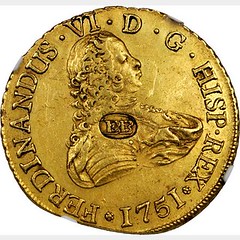
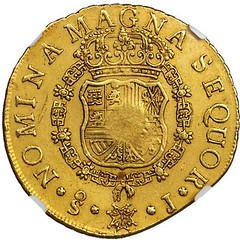
(ca. 1784) Ephraim Brasher regulated Chilean 1751 Santiago 8 escudos ($15). 26.358 grams. AU-53 (NGC). Countermarked once, single diagonal clip. No plug.
As surely as the gold pieces coined by Ephraim Brasher in 1786 and 1787 are Brasher doubloons, so too is this piece, an 8 escudos or doubloon marked by Brasher before he coined what are today multimillion dollar rarities. As interesting as the connection to Brasher's doubloons is, this coin may have a still more interesting tale to tell. Collectors of Latin American gold will recognize the 1751-J 8 escudos issue of the Santiago Mint for its connection to the 1752 wreck of the Nuestra Senora de la Luz. Among the portion of that wreck's riches that were salvaged in the early 1990s, some 74 specimens were recovered from these precise dies, called I/5 or the "high bust" in the 1993 Sotheby's sale of "the Uruguayan Treasure of the River Plate." The portion of the wreck found and sold in modern times was just a small fraction of the coins lost, however, and the introduction to the Rio de la Plata catalog estimates that 90% of the gold coins sent into the water near Montevideo were recovered within a few years of the ship's loss.
This coin may be one of them. It retains a good deal of lustre and some areas of prooflike reflectivity even as areas of the fields, particularly on the reverse, show some scattered faint abrasions that give this coin a seawater appearance. Unlike most of the coins recovered from La Luz, this coin shows actual wear on the devices, in addition to its famous countermark. The Brasher mark, produced by the same punch that stamped Brasher's more famous doubloons, is deeply sunk at the center, noticeably doubled but still crisp and very clearly attributable as the punch by which Brasher gained his numismatic fame.
To read the complete lot description, see:
(ca. 1784) Ephraim Brasher regulated Chilean 1751 Santiago 8 escudos
($15). (https://auctions.stacksbowers.com/lots/view/3-4IFDO)
Lot 8: Ephraim Brasher regulated Brazilian 1726 Minas Gerais 20,000 reis


(ca. 1784) Ephraim Brasher regulated Brazilian 1726 Minas Gerais 20,000 reis ($30). 52.4 grams. XF-45 (NGC). Countermarked once, no clip. No plug. Formerly mounted at 12:00.
A remarkable new discovery and perhaps the most impressive of all Ephraim Brasher regulated coins known, this specimen's title as the largest Brasher regulated gold coin will never be taken from it, as no larger gold coin ever circulated in the American colonies and early United States. The 1842 Manual of Gold and Silver Coins of All Nations by Jacob Eckfeldt and William DuBois of the United States Mint called this denomination "the heaviest coin of modern times" noting that "the five-moidore piece of Portugal [was] struck about a century ago, weighing 828 grains and worth $32.70." In 1846, William DuBois published Pledges of History: A Brief Account of the Collection of Coins Belonging to the United States Mint, where he called this denomination "the largest of gold coins." In 1784, a five moidore such as this was worth $30, nearly twice as large as the Double Joe of 12,800 reis and exactly twice as valuable as a Spanish 8 escudos. The 20,000 reis denomination was coined from only 1724 to 1727, exclusively at the mint in the Brazilian gold-mining district of Minas Gerais. The 4000 reis or moidore, which was coined throughout the 18th century, was so common that its name -- moidore -- literally means "gold coin," from the Portuguese moeda d'ouro. Its value in Federal money was $6, making this coin worth an even $30.
To read the complete lot description, see:
(ca. 1784) Ephraim Brasher regulated Brazilian 1726 Minas Gerais 20,000 reis
($30). 52.4 grams. (https://auctions.stacksbowers.com/lots/view/3-4IFDE)
Lot 9: Joseph Richardson regulated Brazilian 1752 Rio 6400 reis


(before 1777) Joseph Richardson regulated Brazilian 1752 Rio 6400 reis or half Joe. 13.968 grams. AU-55 (NGC). Countermarked and plugged once.
This important early American gold coin was regulated by Joseph Richardson the Elder, one of the colonies' most important gold and silversmiths before his retirement in 1777.
The edges were carefully clipped circumferentially by parties unknown who were enriched by the theft. The delicate diagonal reeding that was placed on the rim after the clipping sought to replace the twin-leaf decoration that was present when this coin was struck, perhaps fooling casual observers but leaving the clipping and cover-up perfectly obvious to advanced observers then and now. To replace the gold missing from the edge, Richardson placed a substantial plug at the center, flat and taut at the central obverse, more bulbous on the reverse where the gold pin was carefully peened down after being slid through a small hole from the obverse. The plug is oval in form on the obverse, round on the reverse. The Richardson mark, IR in a square with no dot between the letters, is familiar from many of his silver works and distinctive from the JR mark of his son, Joseph Richardson the Younger.
The only Richardson regulated coin known to Gordon was the 1730 double Joe (12,800 reis) in the Roehrs Collection. The mark used on that coin is identical to the mark seen here, and both match the 1746 4 escudos of Bogota housed in the Lasser Collection at Colonial Williamsburg. Neither of the other recorded specimens is as well preserved or as physically attractive as this specimen.
To read the complete lot description, see:
(before 1777) Joseph Richardson regulated Brazilian 1752 Rio 6400 reis or
half Joe. 13.968 grams. AU-55 (NGC). Countermarked and plugged.. (https://auctions.stacksbowers.com/lots/view/3-4IFD4)
To read an earlier E-Sylum article, see:
AMERICAN REGULATED GOLD PIECES (www.coinbooks.org/esylum_v19n10a14.html)

STACKS'S BOWERS MAY 2016 RARITIES SALE SELECTIONS
Lot 20: 1806 Draped Bust Quarter. B-9. Rarity-1


1806 Draped Bust Quarter. B-9. Rarity-1. MS-64+ (PCGS). CAC. Secure Holder.
Produced in limited numbers and erratically during the earliest years of U.S. Mint operations, the quarter was not a popular denomination with contemporary silver bullion depositors. Such coins were produced at the request of depositors during the late 18th and early 19th centuries, and those dealing in silver bullion much preferred half dollars and silver dollars over quarters. Even so, calendar year 1806 saw the Mint deliver an unusually large number of quarters for the era -- 206,124 pieces -- those actually bearing the date 1806 eventually requiring 10 die marriages to produce. Browning-9, offered here, vies with B-3 as the most common variety of the issue in terms of total number of coins extant. As a date, of course, the 1806 quarter is very rare in the finest Mint State grades, as indeed is the Draped Bust type as a whole.
To read the complete lot description, see:
1806 Draped Bust Quarter. B-9. Rarity-1
(https://auctions.stacksbowers.com/lots/view/3-4IFDY)
Lot 64: Proof 1894 Quarter Eagle
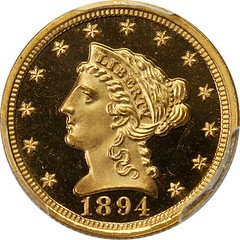
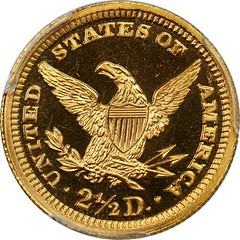
A mintage of 122 pieces for the 1894 represents a slight increase over the previous year in the total number of Proof quarter eagles struck. In keeping with the standards of this classic U.S. Mint gold series, of course, the Proof 1894 is a rare issue in an absolute sense with fewer than 100 coins believed extant in all grades. Estimates on the exact number of survivors are fairly tight between numismatic references, with Jeff Garrett and Ron Guth (2008) providing a figure of 50 to 70 coins and PCGS CoinFacts allowing for 60 to 80 pieces. A fair number of the survivors are impaired due to having been placed into circulation or otherwise mishandled by earlier generations of collectors.
To read the complete lot description, see:
1894 Liberty Quarter Eagle. Proof-66 Deep Cameo (PCGS).
(https://auctions.stacksbowers.com/lots/view/3-4IFRU)
Lot 87 : 1807 Capped Bust Left Half Eagle
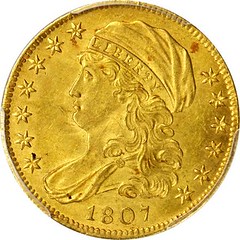

Assistant Engraver John Reich's iconic Capped Bust Left motif made its debut in 1807. The first coins to bear the design were those that were most popular with gold and silver bullion depositors, the half eagle and half dollar. The Mint had improved its processes by this time to greatly extend working die life, so fewer varieties are known for the Capped Bust Left half eagle series as compared to its Capped Bust Right predecessor of 1795 to 1807. Indeed, numismatic scholars have identified only two die marriages for the first year 1807 Capped Bust Left, both of which employ the same obverse.
To read the complete lot description, see:
1807 Capped Bust Left Half Eagle. BD-8. Rarity-2. MS-63 (PCGS).
(https://auctions.stacksbowers.com/lots/view/3-4IEWC)
Lot 145 : 1866 Pattern Liberty Quarter Eagle. Judd-542
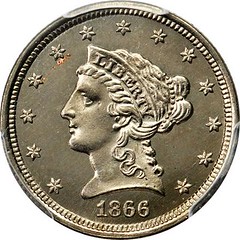
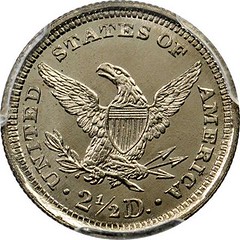
1866 Pattern Liberty Quarter Eagle. Judd-542, Pollock-607. Rarity-7+. Nickel. Reeded Edge. Proof-66 (PCGS). CAC.
This is an intriguing variety and equally curious example. Despite the traditional listing of this type as a regular dies trial striking of the 1866 quarter eagle in nickel, and hence a pattern, modern numismatic scholarship entertains the possibility that Judd-542 may actually be a Mint error. Indeed, when the present example last appeared at auction in April 2015, it was certified MS-66 by NGC and attributed as being struck on a nickel three-cent planchet in error. NGC also provided the weight of this coin -- 2.04 grams -- which is in the range of tolerance for the nickel three-cent piece's authorized weight of 1.94 grams.
As our current listing makes clear, PCGS differs with this assessment and has certified the coin as a pattern under the traditional Judd-542 attribution. (It is as a Judd-542 pattern certified Proof-66 by PCGS that we are offering; interested parties should factor their bids accordingly.) Regardless of its exact status as a pattern or Mint error, this is a very rare type with only four distinct specimens accounted for on the website uspatterns.com. The present example is plated on that site, and it is also the plate coin for the Judd-542 type in the 10th edition of the Judd pattern reference.
Whether deliberately struck in nickel for sale to contemporary collectors or created in error, this is a highly elusive and extremely interesting piece. The rarity of Judd-542 within the pantheon of U.S. Mint patterns is beyond question, as defined above. As a Mint error this coin is rarer still, for it would be one of very few Liberty gold coins of all denominations struck on an incorrect planchet. Worthy of additional study,
To read the complete lot description, see:
1866 Pattern Liberty Quarter Eagle. Judd-542, Pollock-607.
(https://auctions.stacksbowers.com/lots/view/3-4IF6G)
Lot 147 : Christopher Bechtler $1. K-3.
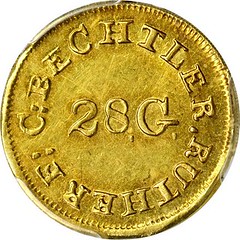

Undated (1834-1837) Christopher Bechtler $1. K-3. Rarity-6. 28.G Centered, No Star. Reeded Edge. MS-61 (PCGS). Secure Holder.
Christopher Bechtler and his son Augustus and nephew Christopher, Jr. operated their own private mint in Rutherfordton, North Carolina from 1830 to 1852. The coins were struck at two sites: at their home in Rutherfordton and near their mine just north of town. Originally housed at the American Numismatic Society Museum, the coin press and several of the dies are currently on display at the Bechtler House Museum in Rutherfordton. The family was among the earliest private minters servicing the nation's first major gold rush in the Piedmont region of North Carolina and Georgia. Kagin-3, offered here, is one of Christopher Bechtler, Sr.'s rarer gold dollars and is seen far less often than the popular N Reversed variety (K-4).
Provenance: Ex Eric P. Newman Numismatic Education Society; Heritage's sale of the Eric P. Newman Collection, Part V, November 2014, lot 3458.
To read the complete lot description, see:
Undated (1834-1837) Christopher Bechtler $1. K-3. Rarity-6. 28.G Centered, No
Star. Reeded Edge. (https://auctions.stacksbowers.com/lots/view/3-4IFFH)
Lot 148 : 1850 Baldwin & Co. $5 Gold
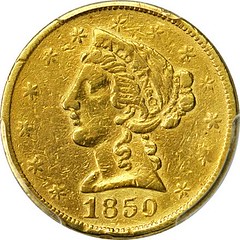
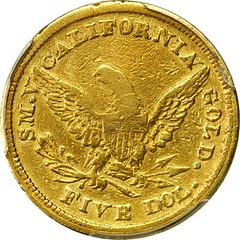
San Francisco-based jewelers George C. Baldwin and Thomas S. Holman operated as Baldwin & Co. during the California Gold Rush. They expanded into assaying and coining in 1850 when they acquired machinery and other equipment from F.D. Kohler, who had been appointed California State Assayer by Governor Peter Burnett on April 12 of that year. While the most famous and eagerly sought Baldwin & Co. coins are the 1850 Horseman type $10, the firm's coinage features other notably scarce and rare pieces, including the legendary 1851 $20 with only four to six examples known.
To read the complete lot description, see:
1850 Baldwin & Co. $5. K-2. Rarity-5.
(https://auctions.stacksbowers.com/lots/view/3-4IFQ1)
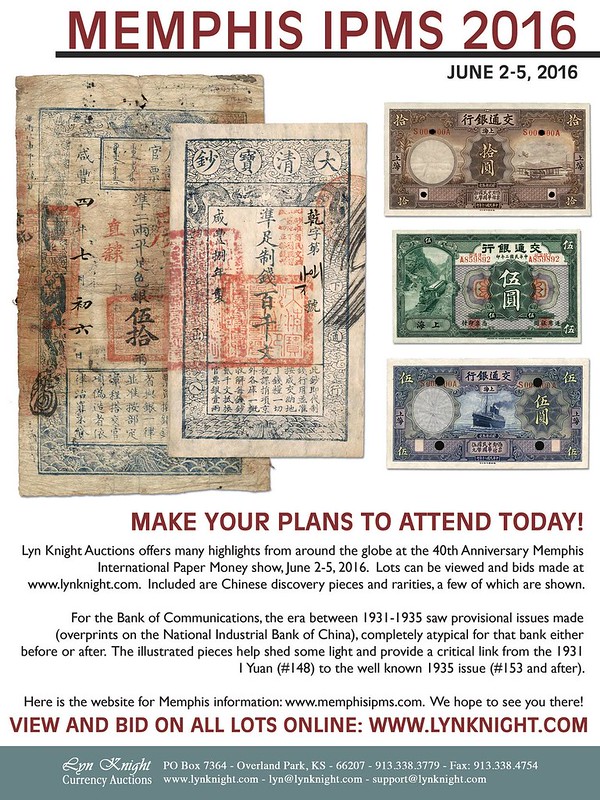
NUMISMATIC AUCTIONS SALE #59 CLOSES JUNE 20, 2016
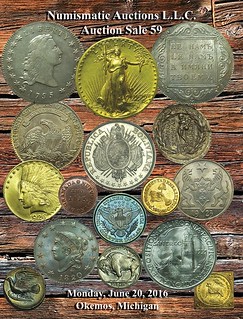 Auction Sale #59 is a highly diverse offering, containing a broad spectrum of items for collectors and dealers alike. A continuing
selection of material is listed from the Andrew L. Tuttle Memorial Museum in this, the fourth segment from that fine collection as well as other fine
consignments. Opening in Session One is a group of United States Colonial coppers and paper followed by type coins and series issues with highlights
in 18th, 19th and early 20th Century along with a group of US Gold and a unique array of Gold Love Tokens, some wonderful coins and tokens of
Hawaiian origin and notes and some unusual exonumia and paper, closing out with a group of Canadian coins, Gold, Maritime and Token issues. The vast
majority of the material in the sale is uncertified and has been off the market for several decades, making it even more exciting.
Auction Sale #59 is a highly diverse offering, containing a broad spectrum of items for collectors and dealers alike. A continuing
selection of material is listed from the Andrew L. Tuttle Memorial Museum in this, the fourth segment from that fine collection as well as other fine
consignments. Opening in Session One is a group of United States Colonial coppers and paper followed by type coins and series issues with highlights
in 18th, 19th and early 20th Century along with a group of US Gold and a unique array of Gold Love Tokens, some wonderful coins and tokens of
Hawaiian origin and notes and some unusual exonumia and paper, closing out with a group of Canadian coins, Gold, Maritime and Token issues. The vast
majority of the material in the sale is uncertified and has been off the market for several decades, making it even more exciting.
Session Two following the United States and Canadian material, is a group comprised of Ancient coinage followed by World Gold and a very interesting and eclectic run of World coins highlighted by a comprehensive collection of Holy Roman Empire Coinage in silver, featuring Talers to minor sized coinage as well as a global collection of Taler coins, A specialized collection of South African and British Commonwealth coinage, another intriguing ensemble of cut & countermarked issues and fantasies and many unusual and seldom offered foreign coins from a plethora of locales such as Africa, Asia, Europe, the Middle East, the Pacific Rim, Central & South America and points beyond. Session Two closes out with many literally massive lots of World Coins, Paper Money, Tokens and Medals from around the planet for the collector, dealer or eBay selling enthusiast. The entire 80 page catalog is profusely illustrated with full color images.
Session Three details a number of items from all corners of the earth geared specifically to the collector, with estimates priced predominantly at $100 and under to invite those who seek to build their collections without spending a fortune. There are many high grade and scarcer issues throughout this session that are highlighted here even though they are not of an elevated dollar value, the consummate World Coin specialists will certainly glean a few jewels from this offering as well.
The firm anticipates an outpouring of participation given the breadth and depth of the sale with affordable items for the collector throughout as well as some higher end rarities. Catalogs are available free of charge by request from Steve Davis at Numismatic Auctions LLC, PO Box 22026, Lansing, MI 48909, Tel: 517-394-4443/ Fax: 517-394-0579, Email: numauctionsllc@aol.com or the entire Sale #59 Auction listing can be viewed online at www.numismaticauctionsllc.com
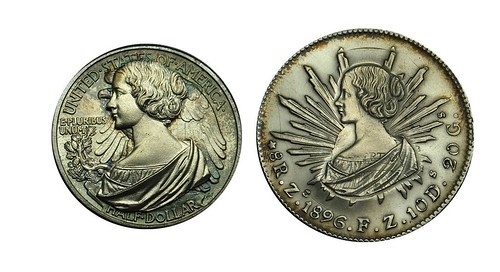
Jenny Lind
Lot 73: 1900 Proof Barber Quarter
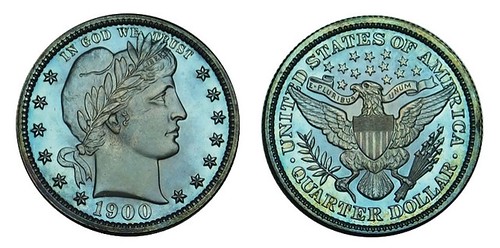
1900. Choice to Gem Proof with exquisite cobalt blue and violet toning. Tremendous eye appeal.
Lot 114: 1795 Flowing Hair Dollar

Flowing Hair Dollar. 1795. 2 Leaves. PCGS XF40. Handsome light golden-gray toning. A truly wonderful scarcer variety and high grade type coin.
Lots 258-260: Gold Love Tokens
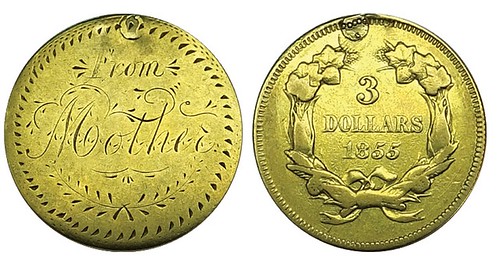

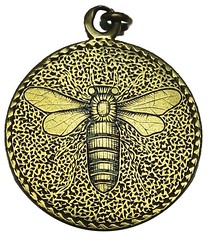
258: Simple cursive style “From Mother” and border on effaced obverse of an 1855 Three Dollar Gold piece, VF, old piercing, plugged with gold long ago
259: Bold dimensional “KNM” monogram with floral style accents on effaced obverse of an 1859 Three Dollar Gold piece with loop intact. VF-EF.
260: . Superbly executed vintage Bee or Moth rendition on bordered, stippled field with black detail upon the effaced reverse of a Three Dollar Gold piece with loop intact. Near EF, host coin VG-Fine. A high art example on a rare denomination.
Lot 330: Hawaii Waterhouse Token
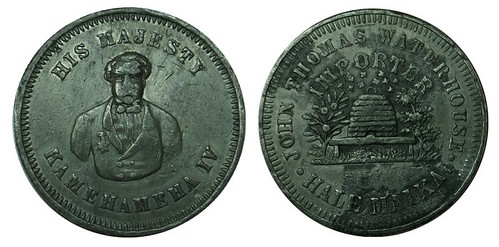
Token Issues. Hawaii Waterhouse Token, ND (1860). Choice VFEF sharpness, a few areas of minor porosity reverse, otherwise nice. Rare Redbook listed issue.
Lot 331: Hawaii T. Hobron Token
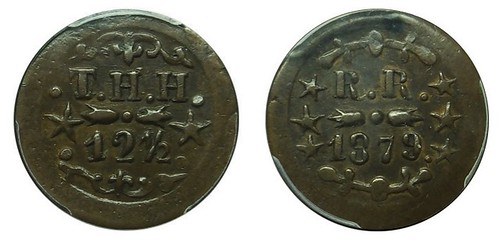
T. Hobron 12 1/2 Cents, 1879. 6/2 Stars. PCGS AU55. Rare issue and grade, these tokens are seldom seen in hig
To view the complete sale catalog, see:
http://www.numismaticauctionsllc.com/uploads/Sale_59_Web_Version.pdf
MEDALS SECRETLY AWARDED TO NAVY SEALS
 Citations for two Navy Crosses and more than 100 Silver Star medals awarded secretly to Navy SEALs and a Marine for “extraordinary heroism”
in the last 15 years reflect the fierce battles that have been fought in Iraq and Afghanistan, according to records obtained by USA TODAY.
Citations for two Navy Crosses and more than 100 Silver Star medals awarded secretly to Navy SEALs and a Marine for “extraordinary heroism”
in the last 15 years reflect the fierce battles that have been fought in Iraq and Afghanistan, according to records obtained by USA TODAY.
The Navy decorated the Marine for saving the lives of civilians in Benghazi in September 2012. Several SEALs earned theirs for intense combat in Ramadi, others for rescuing hostages in Afghanistan. The Navy also honored the deadly efficiency of the “American Sniper,” the late SEAL Chris Kyle.
Almost one in five of the military's most prestigious honors in all the services have been awarded privately since America went to war in 2001 because the missions were classified. The Medal of Honor is the highest commendation, followed by service crosses and the Silver Star. In February, the Pentagon announced plans to review more than 1,000 of the nation's top awards bestowed since 9/11 to determine if they should be upgraded. The secret Navy Crosses and Silver Stars are among those under review, along with a similar number issued for the Army's classified commando missions
"Awards and medals have a sacred role in military culture," said Brad Carson, the Pentagon's former civilian chief for personnel who advocated for the review. "They are a small ribbon symbolizing enormous sacrifice. It is important that we recognize service members for their heroism. And after 15 years of war, it is appropriate to review awards to make sure we applied the criteria correctly and uniformly. That's especially true when so many missions were necessarily classified and awards given quietly. That's why we pushed this review. It is about keeping faith with the troops."
The citations that accompanied the two Navy Cross and 112 Silver Star medals begin as form letters under letterhead from the Secretary of the Navy.
Next, in less than a page, come astounding feats of bravery, selflessness and will.
Two Navy Crosses, second only to the Medal of Honor, are among the Navy documents. The first, on Aug. 9, 2009, a Navy SEAL, his name blacked out like others in the report, was leading a small unit when their base came “under an intense coordinated attack” in Afghanistan. A sniper wounded the unit's medic, and the SEAL braved direct gunfire to drag the man to safety.
At the same time, a rocket-propelled grenade smashed through the wall of the unit's arsenal, sparking a major fire. “With a catastrophic explosion imminent,” the SEAL evacuated the base. He then ran repeatedly into the arsenal to haul out crates of explosives to uncover the “smoldering and undetonated warhead, which he removed with his bare hands.” He left the compound, making several trips to dump explosives in a nearby river, all the while being shot at.
Missing from the citations is any mention of SEAL Team 6 and its mission into Pakistan that killed Osama bin Laden in 2011. President Obama did provide the commandos with the Presidential Unit Citation, the highest honor for a military unit. The Navy did not rule out the possibility that individual medals were awarded.
To read the complete article, see:
Navy SEALs
secret medals reveal heroism during past 15 years
(www.usatoday.com/story/news/politics/2016/05/15/navy-seals-secret-medals-reveal-heroism-during-past-15-years/84242220/)
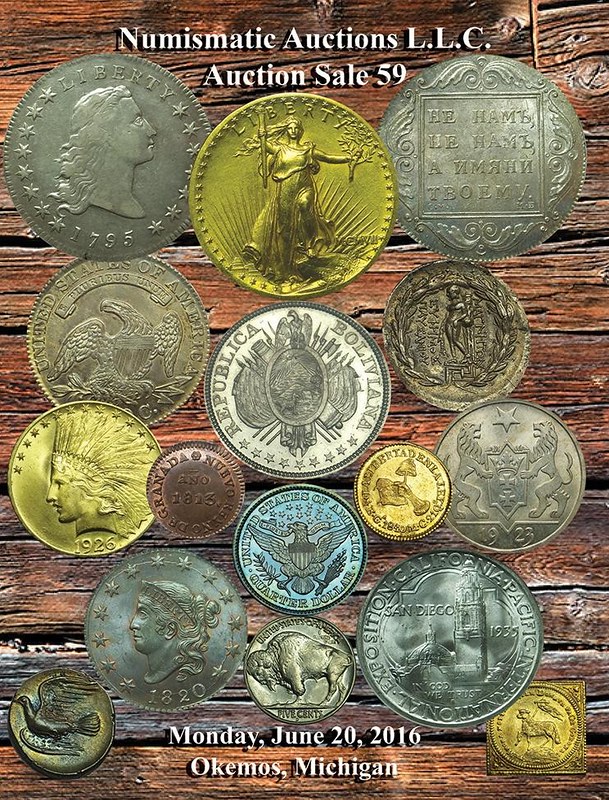
THE 2016 KATY RAILROAD COMMEMORATIVE MEDALS
Jeff Starck of Coin World writes:
Parsons, Kan., holds the annual Katy Days festival, recalling the Kansas-Texas railroad line (which I believe went through Oklahoma for the O-K-T and Missouri as the M-K-T line).
Festival organizers have issued medals for several years, and have revealed designs for this years' medals.
It's always fun when local organizations issue medals today, and is certainly more uncommon than the heyday of the 1960s.

This year's Katy Railroad commemorative coins feature an old inspection car, the last leader of the company and a Katy subsidiary.
For four years, the Katy Days committee has designed and had made a three-coin set commemorating the railroad that was responsible for the founding of Parsons and that the community celebrates each year during the Memorial Day weekend festival. The coins each have the red MK&T emblem on one side and separate depictions on the opposite side. One coin has a copper tone, while another features a silver tone and a third a gold tone.
“By the time it's all said and done, we only have 50 of these to sell to the general public, so they are very, very limited edition,” Steve Ferrell of rural Parsons, a Katy Days committee member, said.
The public can buy individual coins at varying prices, depending on how many are purchased, or an entire set, which costs $35 for one or $30 apiece for two or more. Orders can be placed by emailing Katy_Days@yahoo.com or calling (800) 280-6408.
The bronze-toned coin features MK&T Inspection Car 1045. Farrell said the car was a former box car that was retrofitted into an observation car. Katy officials rode in the car to inspect the track. It was attached to the rear of a train and was more low-slung than the cabooses, offering a better view.
The silver-toned coin features Harold Gastler, the last president of the Katy. He served in that role from 1975 to 1988, overseeing the merger of the Katy Railroad with the Union Pacific Railroad.
To read the complete article, see:
Katy Days board offers 2016 coins
(www.parsonssun.com/news/article_0f4dafe6-1344-11e6-b752-038a39b95946.html)
MIAMI OKLAHOMA 125TH ANNIVERSARY MEDAL
Here's one more from Jeff Starck of Coin World, who writes:The town of Miami, OK, in the northeast part of the state is celebrating its 125th anniversary with a medal. The medal celebrates the town's connection to Route 66, the high school mascot the Wardogs and the Nine Tribes found in the region, which coordinate as the Inter-Tribal Council centered in Miami. In addition, the medal references Northeast Oklahoma A&M College.
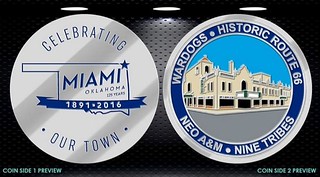 Coins commemorating Miami's 125th birthday celebration are now on sale.
Coins commemorating Miami's 125th birthday celebration are now on sale.
“The coins are a nice addition to the celebration,” said Amanda Davis, executive director of the Miami Convention & Visitors Bureau (CVB) and director of tourism for the City of Miami.
The CVB helped spearhead an anniversary celebration in March that included a parade, concerts and other activities. “It's a tradition that we were quickly made aware of when we began planning for the event,” Davis said. “Many Miamians that were present for past celebrations have stopped at the CVB to show me their collections of the special anniversary coin. It will definitely be a keepsake.”
Cost of the coins are $15 each and are available at the Miami CVB office, 101 North Main.
To read the complete article, see:
Miami 125th commemorative coins on sale
(www.miamiok.com/article/20160517/NEWS/160519552)
To read the earlier E-Sylum article, see: VOCABULARY ANSWER: QUASQUICENTENNIAL (www.coinbooks.org/esylum_v04n08a08.html)

SELECTED MEDALS OF BOGOMIL NIKOLOV
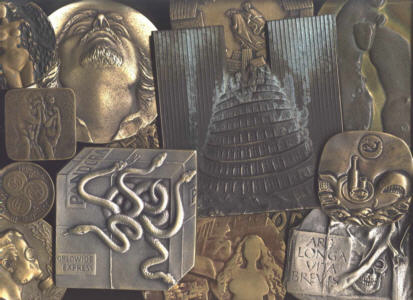
Following last week's item about medals offered by New York's Medialia Gallery, Jeanne Stevens-Sollman writes:
I thought readers might also be interested in the work Bogomil Nikplov is doing in Bulgaria. I have a medal published in his cyber gallery.
Self Portrait

Apple

RADA, 1 YEAR OLD
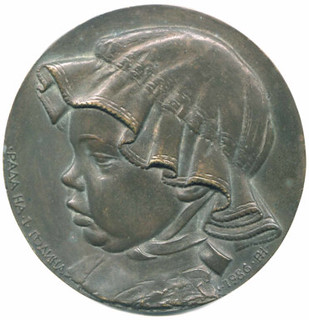
TICK- TOCK

For more infomration, see:
www.fidem-medals.org/student%20projects.html
www.artmedal.net/bulgaria/
www.bogomil-nikolov.artmedal.net/
www.bestexpressnetworks.com/bogomil.htm
http://www.coins-and-medals.ru/events/?en
To read the earlier E-Sylum article, see:
MEDIALIA GALLERY (www.coinbooks.org/esylum_v19n20a20.html)
MACRO & MICRO LENSES FOR SMARTPHONE CAMERAS
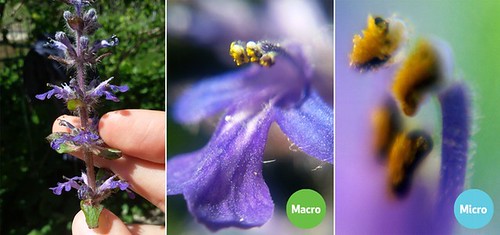
BLIPS is an ultra portable and very affordable set of 2 mini lenses which turns your devices into digital microscopes in seconds!
You can cut the film using scissors, shaping BLIPS as you prefer. The two sticky bands are meant to enhance adherence onto non-polished surfaces; the lens will always stick on the glass when the surface is clean.
 BLIPS has been developed within the neuroscience labs of the Istituto Italiano di Tecnologia (IIT) exploiting the materials and the methods
used for the manufacturing of micro devices for the investigation of neuronal networks. Although it was born in a research lab, it has been designed
for mass production from the very beginning.
BLIPS has been developed within the neuroscience labs of the Istituto Italiano di Tecnologia (IIT) exploiting the materials and the methods
used for the manufacturing of micro devices for the investigation of neuronal networks. Although it was born in a research lab, it has been designed
for mass production from the very beginning.
It allows you to take high definition macro pictures with optical magnification of about 10 times. It is extremely thin, about 1/50 inch (0.5mm), and very user friendly. It represents the first step from “standard” photography towards portable microscopy. Its working distance, i.e. the distance between the lens and the focal plane, is of about 1/2 inch (12mm).
Hence, it can be used like a high power magnification lens for precision works or for several other applications where an enhanced electronic eye is desired, from technical uses to sheer fun.
To read the complete article, see:
BLIPS: The Thinnest Macro & Micro Lenses For All Devices
(/www.kickstarter.com/projects/blips/blips)
FOCUS-STACKING PHOTOGRAPHIC TECHNIQUE
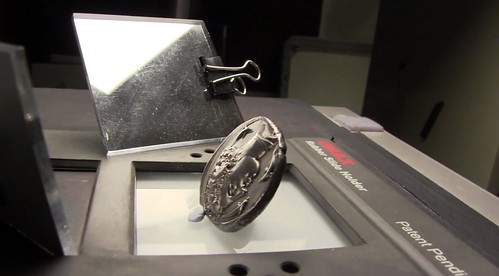
ANS photographer Alan Roche created the short video below to describe the “focus-stacking” photographic technique to produce high-definition, 3D-like images of coins in fantastic detail. Have a look:
To read the complete article, see:
NEW FOCUS-STACKING PHOTOGRAPHIC TECHNIQUE FOR
COINS (www.anspocketchange.org/new-focus-stacking-photographic-technique-for-coins/)

ROYAL MINT EXPERIENCE CENTER OPENS
The day before its official opening, the Royal Mint previewed the new visitor's center based in Wales, which they have appropriately entitled “The Royal Mint Experience.” A small list of guests were invited in before the doors opened to the public, and luckily I was among them.
Although I was given a personal tour by one of the Royal Mint's resident coin experts from start to finish, I felt as though I could easily take the tour again to get a better look at the many coins and informative videos on display. There's a lot of information to take in as it all represents over a thousand years of coin-making. The Royal Mint has done well to ensure visitors are knowledgeable by the time they take their leave.
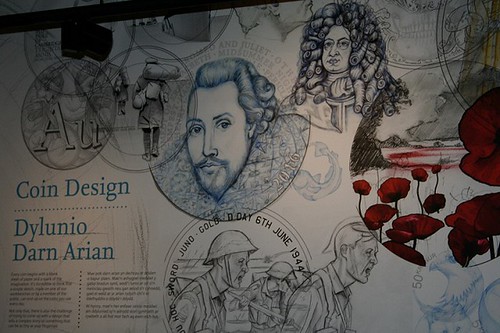
When you arrive at their immense production facility, opened by Queen Elizabeth II in 1968, you are welcomed by a modern, new purpose-built annex to the main complex that has its own entrance aside from the business entrance of the Mint. A large lobby offers you the choice of going directly to the retail and souvenir shop to the left of the entrance or to the large naturally sunlit café that opens to a terrace with outdoor seating.
Unless you're in need of some refreshments, make your way directly to the first chamber of the tour which includes an introductory video explaining the origins of the Royal Mint — after all they are the country's oldest continuing business entity, having produced the coinage of the realm since the 9th century, beginning with Alfred the Great's first silver pennies. After passing through security gates — you are entering the actual grounds of the Mint so checks are in effect — you are led by your tour host to the first chamber, which includes a welcome video. The video is short but informative; from there the behind-the-scenes excitement begins.

A video demonstrates medieval hand striking coins.
The next phase of the experience is where the visitor's center excels. This is when you are guided to the actual floor of production, but first things first. A new exhibit has been added to a former lobby that includes a set-up of the preliminary steps of coin production. On display are large bricks of metal that are destined to become someone's pocket change, with ingots and pressed rolls of suitable plates where the blanks are punched out of for eventual minting. Dies and collars — the part of the coin which becomes the edge of all coins — are explained, and machinery is used to demonstrate how the letters found on many British and international coinage are added to increase security. There is a current set of dies of the British circulation coins on display, including the latest obverse portraits of the Queen as well as some of the newest reverse designs for both circulation and commemorative coins.
The next stop is where the coins of over 60 countries are produced, including those of the United Kingdom. The main floor of production for the Royal Mint is in use and minting coins 7 days a week, 24 hours a day, except during holidays. Here visitors can see for the first time just how the production is carried out without receiving a special invitation from the management, or having to wear a hardhat and safety vest.
 As the visitor's center has at its disposal the consultancy of the museum of the Royal Mint, there is a great possibility that in addition
to those rarities currently on display future exhibitions will feature many more coins seldom seen by the public.
As the visitor's center has at its disposal the consultancy of the museum of the Royal Mint, there is a great possibility that in addition
to those rarities currently on display future exhibitions will feature many more coins seldom seen by the public.
With the preview tour concluded, it was time to catch up with those members of Royal Mint management and staff that have had a direct hand in the completion of the new complex to thank them for their hospitality. I thoroughly enjoyed myself; this enterprise was indeed long overdue and I'm glad it has finally become a reality.
Whether you are a genuine coin fanatic or just mildly curious as to how a small metal disk is turned into one of the coins found in your pocket, I wholly recommend a visit to the new Royal Mint Expe
To read the complete article, see:
Grand Opening:
“Royal Mint Experience” Visitor Center Welcomes Coin Enthusiasts and Friends
(http://news.coinupdate.com/preview-royal-mint-experience-visitor-center-welcomes-coin-enthusiasts-and-friends/)
BISHOP CAMERON'S COMMEMORATIVE ROUND POUND

THE FINAL commemorative round pound coin features a design created by the Bishop of St Asaph.
Royal Mint chose the Rt Revd Gregory Cameron “last minute” design - based on four heraldic beasts - following a competition. The small piece of metal - showcasing The Welsh dragon, English lion, Scottish unicorn and a stag for Northern Ireland and even the Bishops initials - can be snapped up before it changes from currency to history on the Royal Mint website. Prices start from £10, the most expensive is a gold proof coin for £895.
The round pound coin is to be replaced next year by a new twelve sided coin. The very last circulating round pound was struck by The Royal Mint in December 2015.
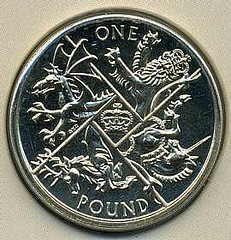 The Bishop said: “I am absolutely delighted that I have designed the very last commemorative round pound coin. As it is a non-circulating
edition of the coin it will always be a very rare coin and, I hope, treasured.
The Bishop said: “I am absolutely delighted that I have designed the very last commemorative round pound coin. As it is a non-circulating
edition of the coin it will always be a very rare coin and, I hope, treasured.
“In my design, the four heraldic beasts are equal. Each has its quarter of the coin. There is also some cross-over parts - the dragon's wing, for example, crosses into the lion's quarter. That makes it more dynamic and also symbolic as it shows four separate nations, all an equal part, yet interlinked as they protect Britain's sovereignty, the Crown.”
Bishop Gregory, an amateur artist and coin collector, began his ministry in the church in 1983 - the year the £1 coin was introduced.
 He entered three designs into the Royal Mint competition, two based on the flowers of the four nations and a last minute design based on
Royal beasts.
He entered three designs into the Royal Mint competition, two based on the flowers of the four nations and a last minute design based on
Royal beasts.
The Bishop added: “The most challenging part was the stag as I hadn't attempted that before. As people have a clear idea of what they look like, it had to be realistic.”
To read the complete article, see:
Bishop's designs final
commemorative round £1 coin (www.newsnorthwales.co.uk/news/162212/bishop-s-designs-final-commemorative-round-1-coin.aspx)
THE BOOK BAZARRE
NEW-YORK HISTORICAL SOCIETY ANTI-SEMITISM EXHIBIT
The 1000-Reichsmark bills on display at the New-York Historical Society's “Anti-Semitism 1919-1939” exhibition seem almost unused, fresh from the 1922 German mint, probably because rampant inflation quickly made them worthless. That also made them ripe for resurrection by the Nazis 10 years later, when they were overprinted with campaign slogans, swastikas and caricatures. Stamped over one bill's original engraving, Gothic German text proclaims: “The Jew takes our Gold, Silver and Bacon [Speck], and leaves us with this crap [Dreck].” The Dreck—Weimar's worthless currency—is evidence of the Jews' nefarious powers. “Come to Hitler,” the recycled banknotes urge.
Another form of currency is also displayed at this compact but powerful exhibition of more than 50 German artifacts: a five-Reichsmark “currency conversion note” issued between 1933 and 1935. Soon after Adolf Hitler took power, Jews were dismissed from the civil service, Jewish businesses were boycotted and other restrictions were imposed: As the exhibition's catalog tells us, the Nazis saw this as Wiedergutmachung—making good again—reparations for Judaic evils done to Germany. Jews emigrating surrendered German currency in exchange for these notes, supposedly good for later conversion into foreign currencies. Only they weren't. Thus, the Jew who made currency worthless got worthless currency in return. Such was Nazi Wiedergutmachung.
But what do these unusual bills demonstrate about the nature of Nazi anti-Semitism? Is there any connection between the objects in this exhibition and contemporary Jew hatred, which is gaining respectability? This is not a simple matter, because the exhibition is so specific to its time and place. That is how it first must be understood. These artifacts were all acquired by Kenneth W. Rendell for the Museum of World War II he has established in Boston, which is planning an expansive new building. They trace, as the exhibition puts it, the “incremental stages by which anti-Semitism moved from ideology to state policy and finally, to war.”
To read the complete article, see:
‘Anti-Semitism 1919-1939' and ‘Stolen Heart: The Theft of Jewish Property in Berlin's Historic City Center, 1933-1945' Reviews
(www.wsj.com/articles/anti-semitism-1919-1939-and-stolen-heart-the-theft-of-jewish-property-in-berlins-historic-city-center-1933-1945-reviews-1463002058)
For more information about the exhibition, see: Anti-Semitism 1919–1939 (www.nyhistory.org/exhibitions/anti-semitism-1919%E2%80%931939#)
THE ZERO RUPEE ANTI-CORRUPTION NOTE

Inspired by the nonviolent activism of iconic social reformist Mahatma Gandhi, an Indian nonprofit organization called 5th Pillar is addressing the country's problem of corrupt officials by handing them fake money.
The key to the operation is a tool called the Zero Rupee note. This blatantly false, oversized purple bill, complete with Gandhi's portrait, can be handed to any officials who ask for a bribe in order to shame them into changing their behavior. The note communicates that not only will a person not pay a bribe, but also that they are not alone — they are part of a movement of people who support them in ending corruption.
“The Zero Rupee note is a very good weapon, it instills fear in corrupt officials and it forces them to be ashamed of what they are doing,” says Omesh Naturajan, a retired bus driver from the southern part of Tamil Nadu who decided to volunteer with 5th Pillar after the group helped him settle a land dispute. “I've issued around 5,000 notes in my district and used it in several departments."
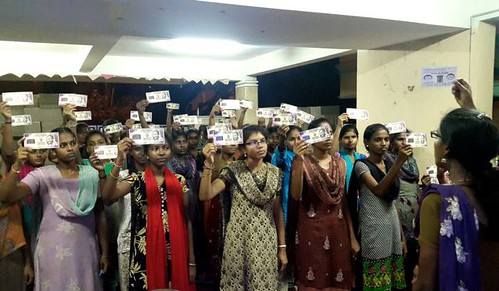
The organization — whose name invokes the power of the people in a democracy — was founded in 2007 by Vijay Anand, an Indian engineer working in the US. Though 5th Pillar is nearly a decade old, the nonprofit, which is based in the southern city of Chennai, has only two small offices and just handful of full-time employees.
“The most important piece of advice we give to anyone that comes to us is to not act violently or be rude or raise your voice at an official,” she says, adding that you have to stay firm about what you want and not leave until you accomplish your task.
Sometimes, this involves the Zero Rupee bill. The Zero Rupee note has grabbed the attention of many Indians as well as the attention of the international media. 5th Pillar estimates that 2.5 million notes have been distributed across the country in the last nine years. While the overall impact is difficult to quantify, Gunasekhar and the volunteers that work with her have countless first-hand anecdotes of its success.
"Since the day we've started distributing the note, we've had people call us saying that they got their job done without paying a bribe,” she says.
To read the complete article, see:
How a non-profit in India is fighting
corruption with fake money (www.pri.org/stories/2016-05-17/how-non-profit-india-fighting-corruption-fake-money)
To read the earlier E-Sylum article, see:
THE ZERO RUPEE BRIBERY NOTE (www.coinbooks.org/esylum_v13n05a19.html)
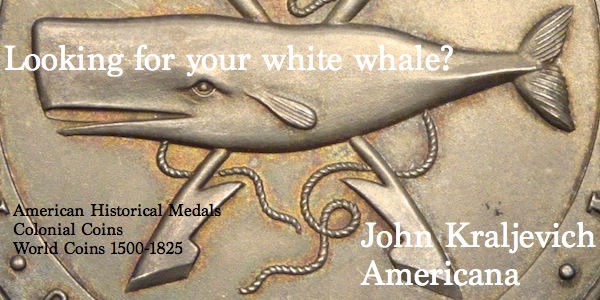
LIBYAN FACTIONS TO ISSUE DUELING BANKNOTES
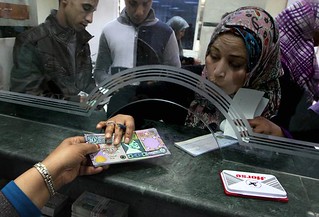 The risk of economic chaos caused by billions of dollars worth of rival banknotes starting to circulate in Libya may fatally undermine the
new unity government in Tripoli, senior European diplomats fear.
The risk of economic chaos caused by billions of dollars worth of rival banknotes starting to circulate in Libya may fatally undermine the
new unity government in Tripoli, senior European diplomats fear.
A political battle between the UN-recognised Tripoli government led by Fayez Sarraj and the Tobruk-based parliament loyal to General Khalifa Haftar in the east has led to parallel splits in the country's financial institutions, with two central banks threatening to circulate rival Libyan dinar banknotes in the country.
De La Rue, the Basingstoke-based currency printer and a long-term supplier of notes to the Libyan government in Tripoli, sent 70m dinars, worth about $50m, to the country last month and is in the process of delivering a further 1bn dinars before and during Ramadan.
A rival bank governor in the east, Ali Salim al-Hibri, once recognised as the bank governor by the IMF, claims to have printed 4bn dinars worth of banknotes with the help of the Russian state.
The two currencies would have different serial numbers, security details and watermarks, diplomats say. The danger is two central banks flooding the country with conflicting currencies that are not interchangeable in banks. They are also likely to worsen inflation. Food inflation has reached 14% a year.
The Wall Street Journal has reported that the central bank in the east holds nearly $185m in gold and silver coins in its British-made vault, but is unable to access it because the code is retained by the Tripoli central bank.
The conflict over the banknotes is liable to worsen the country's longstanding banking liquidity crisis, caused by a reluctance of Libyans to deposit their cash in banks. The shortage of cash in banks has led to long queues and strict limits on the amount than can be withdrawn.
To read the complete article, see:
Battle of the banknotes as rival
currencies are set to be issued in Libya (www.theguardian.com/world/2016/may/20/battle-of-the-banknotes-rival-currencies-libya)
A MONETARY HISTORY OF ISLAMIC SOCIETIES
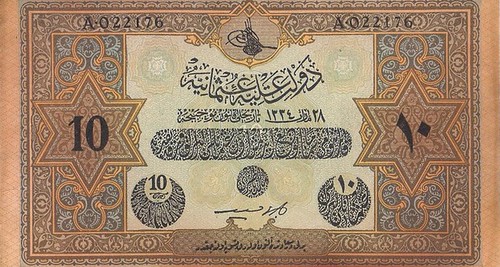
The use of money dates back thousands of years. As in other cultures, minting of coins and banknotes was a reflection of a ruler's power in Islamic societies, although their shapes and names have changed over and over again
Before the arrival of Islam, Arab, Persian and Roman gold and silver coins were used in Mecca and Prophet Muhammad used these coins as well. Caliph Umar was the first ruler that issued coins in Islamic history. In 640 A.D., 18 years after the Hegira, Umar issued short, thick coins in the shape of kernels, weighing 3.36 grams and reminiscent of Persian coins. Caliph Uthman issued gold and silver coins in 650 B.C. The first round silver coin was issued by Caliph Abd Allah ibn al-Zubayr (680-692) in Mecca. Most of the Islamic states issued coins. Gold and silver coins issued with a certain weight are called "sikke."
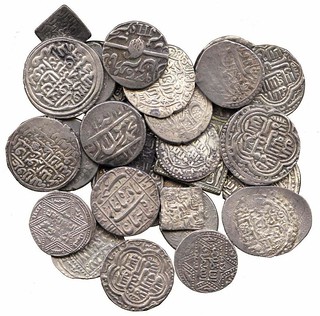
Islamic silver coins from the Abbasid and Ayyubid caliphates
Although Seljuk coins were used in the early Ottoman period, Sultan Osman I, the founder of the Ottoman Empire, issued the first Ottoman silver coin called "akche." These akches weighed 0.68 grams at first, but they later varied in weight. In the 17th century the amount of silver used in akches was reduced one-sixth. The very first Ottoman golden coin was issued by Mehmed the Conqueror in 1478. Later on, various coins were issued and several laws were introduced to standardize coin minting.
During the reign of Sultan Murad I, copper coins called "mangýr" or "fülüs" were issued to facilitate purchasing less valuable products. The amount difference between the coins' expense and their written value were recorded in the treasury. The practice of printing the date on coins started with Sultan Bayezid I and printing the sultan's signature, or "tughra," on coins became regular practice Sultan Mehmed I. Apart from Ottoman coins, Venetian, Polish, Dutch, German, French, Egyptian and Persian coins also circulated in the Ottoman Empire. Since the arrival of money, gold and silver have been considered currency in every community whether the coins bore the portrait of Napoleon Bonaparte or an Ottoman sultan.
Akche, the silver coin, was the official currency of the Ottoman Empire. The gold coin was considered big money while mangýr was on the other end of the spectrum. After 1687, "kurush" were announced as the official Ottoman currency.
Three mangýrs (aka "pul") were equal to one akçe, three akches were equal to one "para," 40 paras were equal to one silver kurush and 100 kurush were equal to 1 Ottoman gold coin.
Whenever a new sultan succeeded to the throne, he prohibited the use of the coins issued by his predecessor and introduced new ones. The public took the old coins to the state mint and they were melted and minted into new coins for a small fee. As the treasury was drained with wars, the amount of silver in akche was reduced, but this caused dissatisfaction among the public. During the reign of Sultan Abdülmecid, the akche was withdrawn from circulation and instead silver coins called "majidiya," which weighed 24 grams, were issued. An Ottoman gold coin of 7.2 grams was equal to five majidiyas, one majidiya was equal to 20 silver kurush and 1 kurush was equal to 40 paras.
To read the complete article, see:
A monetary history of Islamic societies
(www.dailysabah.com/feature/2016/05/20/a-monetary-history-of-islamic-societies)

MISTAKE IN DNA HELIX ON TURKISH LIRA BANKNOTE

Nobel Prize in Chemistry laureate Aziz Sancar has said he has found a mistake on the reverse of Turkey's 5 lira banknote, which shows a left-handed Z-DNA helix.
Speaking during a visit to schools in Istanbul's Üsküdar district on May 21, Sancar said the left-handed Z-DNA helix on the reverse of the banknote mistakenly wound from left to right.
He added that he informed the Central Bank about the mistake five years ago but there had been no change yet.
Issued on Jan 1, 2009, the left side on the reverse of the 5 lira banknote features a portrait of Turkish scientist Adnan Sayýlý along with pictures of the left-handed Z-DNA helix, atomic symbols, the solar system, and hand figures.
Sancar, who currently works at the University of North Carolina, was among three scientists awarded the Nobel Prize in Chemistry in 2015 for their work on DNA repair. He won the prize along with Tomas Lindahl and Paul Modrich for their work in mapping cells that repair ultraviolet damage to DNA.
To read the complete article, see:
Nobel laureate Sancar finds mistake in DNA helix
on Turkish Lira banknote (www.hurriyetdailynews.com/Default.aspx?pageID=238&nid=99490&NewsCatID=374)
COINS AMONG STUNNING FIND AT ISRAELI PORT
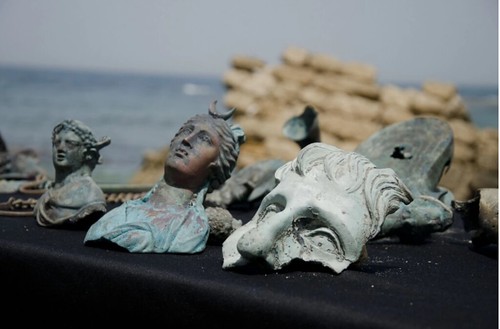
For Ran Feinstein and Ofer Ra'anan, two friends on a diving trip off of the Israeli coast, what began as a typical Mediterranean excursion took a stunning turn.
The two men spied a castaway sculpture sitting amid the rocks and silt on the seabed. This was no average oceanic detritus. The figure, it started to dawn on the divers, must have been ancient. Indeed, according to the archaeologists, it's the largest cache of Roman objects to be found in Israel in 30 years.
“It took us a couple of seconds to understand what was going on,” Ra'anan told the Associated Press. The duo realized the sculpture wasn't alone — this spot was rife with hoary items. They had found the remnants of a Roman merchant ship, lost at sea some 1,600 years ago near Caesarea, a harbor city perched on the Israeli coast roughly 30 miles north of Tel Aviv.
Recognizing the artifacts belonged in a museum, or were at the very least covered by Israel's Law of Antiquities, the divers contacted the state-run Antiquities Authority. When the government archaeologists arrived at the site, what they beheld almost defied belief: a bronze lamp featuring Sol, the sun deity; several iron anchors; a statue of moon goddess Luna; jugs for drinking fresh water at sea; a whale figurine; and an item the Antiquities Authority described in a news release as a “bronze faucet in the form of a wild boar with a swan on its head.”
 Perhaps the most surprising finds are two large masses of metal, thousands of coins clotted together in the ceramic jars that once held
them. The 1,600-year-old coin clusters tip the scales at about 44 pounds. Based on the coins, the archaeologists have a rough idea of when the
merchant ship sank. It was a time when the Roman Empire was on the cusp of Christianity. Some coins bear the visage of Constantine the Great, the
ruler of the western half the Roman Empire who converted it into a new, holier-than-before version in the early 4th century. Other coins show
Licinius, whom the Israel Antiquities Authority describes as Constantine's rival Roman ruler to the east, who reigned from A.D. 324 to 337.
Perhaps the most surprising finds are two large masses of metal, thousands of coins clotted together in the ceramic jars that once held
them. The 1,600-year-old coin clusters tip the scales at about 44 pounds. Based on the coins, the archaeologists have a rough idea of when the
merchant ship sank. It was a time when the Roman Empire was on the cusp of Christianity. Some coins bear the visage of Constantine the Great, the
ruler of the western half the Roman Empire who converted it into a new, holier-than-before version in the early 4th century. Other coins show
Licinius, whom the Israel Antiquities Authority describes as Constantine's rival Roman ruler to the east, who reigned from A.D. 324 to 337.
The find is remarkable for two reasons, the archaeologists say. First, the objects are well-preserved and were only recently exposed on the ocean floor. Covered in a layer of sand, the figures and coins show little evidence of the nearly 2,000 years that have passed. And second, because the Romans frequently melted down metal statues to recast them anew, few such figures exist today.
The accident was, ultimately, the artifacts' salvation.“Because these statues were wrecked together with the ship,” Sharvit and Dror said, “they sank in the water and were thus ‘saved' from the recycling process.”
To read the complete article, see:
Two divers discover 1,600-year-old Roman shipwreck and priceless treasures off of Israel's coast
(www.washingtonpost.com/news/morning-mix/wp/2016/05/17/two-divers-discover-1700-year-old-roman-shipwreck-and-priceless-treasures-off-of-israels-coast/)
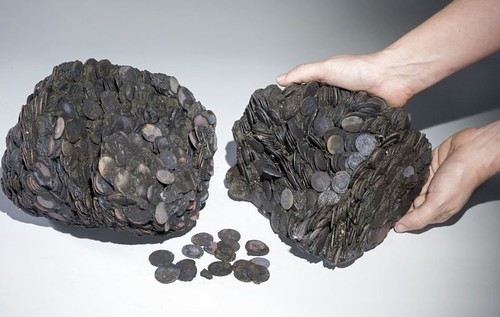
To read the complete article, see:
Treasure trove found
in ancient sunken cargo ship off Israel
(www.foxnews.com/science/2016/05/17/treasure-trove-found-in-ancient-sunken-cargo-ship-off-israel.html)
COINAGE OF THE MONGOLS
As nomads, the Mongols had little use for money. They measured wealth in horses, sheep and cattle. They valued well-made weapons, bridles and saddles. But when they came to rule the sophisticated urban economies of central Asia, Iran, and China they had to adopt forms of currency that were familiar and acceptable to these populations.
Coins of the Mongol empire therefore fall into two categories.
Coins for use in Muslim areas follow the well-established pattern of Islamic coinage: gold, silver and copper denominations with Arabic inscriptions and geometric decoration.
Coins issued for East Asian parts of the empire look Chinese – mainly cast bronze with a square hole in the center.
But there are exceptions to these patterns, many of great rarity and historic interest. A wide variety of languages and writing systems appear on the coins of Mongol rulers, and while there were no portraits there are occasional pictorial designs.
Genghis Khan
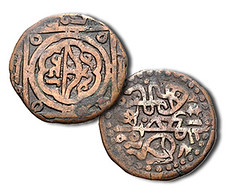 The gold and silver issues bear the Khan's name on one side, and an Arabic inscription with the name and titles of the Muslim caliph, a
powerless figurehead under the thumb of warlords in distant Baghdad, on the other.
The gold and silver issues bear the Khan's name on one side, and an Arabic inscription with the name and titles of the Muslim caliph, a
powerless figurehead under the thumb of warlords in distant Baghdad, on the other.
The only silver coin type bearing the name of “The Just, The Great, Genghis Khan” in Arabic was a dirhem of about three grams,
first issued around 1221.
The Golden Horde
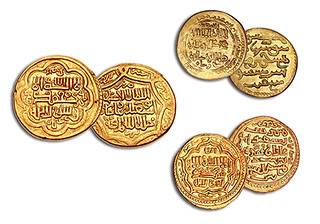 The coinage of this period was minted at Saray on the lower Volga river. These small, crudely-struck silver pieces weighing less than a
gram bear Batu's tamgha or clan symbol–a double-ended trident (reminiscent of Zeus' thunderbolt or Indra's vajra)–on both sides.
The coinage of this period was minted at Saray on the lower Volga river. These small, crudely-struck silver pieces weighing less than a
gram bear Batu's tamgha or clan symbol–a double-ended trident (reminiscent of Zeus' thunderbolt or Indra's vajra)–on both sides.
Berke converted to Islam, and later coins of the Golden Horde generally bear Arabic religious inscriptions.
Jani Beg, Khan of the Golden Horde from 1342 to 1357 placed the image of a lion (looking like a rather scruffy dog) on some of his coins.
Into China: The Yuan Dynasty
 The earliest Mongol coins may be very rare cast silver pieces (about 2.5 grams) with a square hole in the center and four Chinese
characters on one side (Ta Chao Tong Bao) meaning “Great Dynasty Currency”. Examples have been found at Karakorum, the capital of the Great Khans in
Mongolia. Some experts attribute these to Genghis Khan (before 1227); others argue that they were produced under Kublai (ca. 1260 – 1280). About 250
examples are known. In a 2012 auction one sold for US$1,350 (Stephen Album Rare Coins Auction 14, Lot 851).
The earliest Mongol coins may be very rare cast silver pieces (about 2.5 grams) with a square hole in the center and four Chinese
characters on one side (Ta Chao Tong Bao) meaning “Great Dynasty Currency”. Examples have been found at Karakorum, the capital of the Great Khans in
Mongolia. Some experts attribute these to Genghis Khan (before 1227); others argue that they were produced under Kublai (ca. 1260 – 1280). About 250
examples are known. In a 2012 auction one sold for US$1,350 (Stephen Album Rare Coins Auction 14, Lot 851).
The complex Chinese written characters were unsuitable for writing the Mongol language, and Kublai commissioned a Tibetan monk and court official named Drogön Chögyal Phagpa to design a universal alphabet of 36 letters that could be used for all the languages of the empire. This intricate, angular script appears on many coins of the Yuan dynasty, either alone or in combination with Chinese characters.
To read the complete article, see:
(www.coinweek.com/expert-columns/mike-markowitz/coinweek-ancient-coin-series-coinage-mongols/) CoinWeek Ancient Coin Series: Coinage of the
Mongols
To read the earlier E-Sylum article, see:
NEW BOOK: COINS OF THE GOLDEN HORDE
(www.coinbooks.org/esylum_v19n20a03.html)
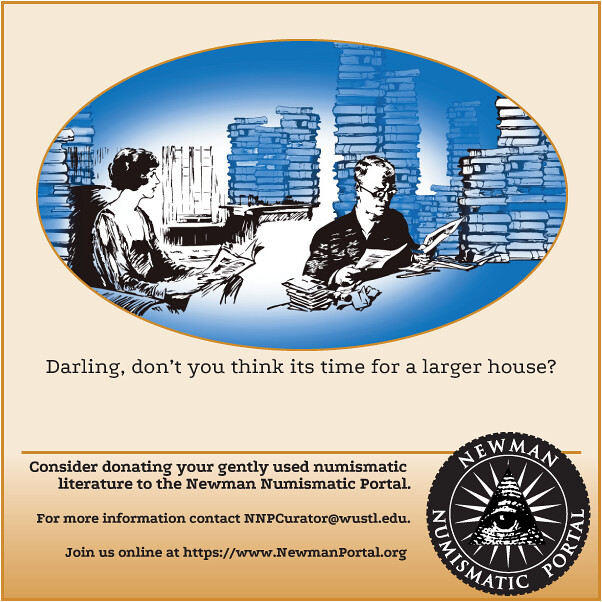
U.K. BARBER CALLS FOR TAX ON BEARDS
A BARBER has waged war on free facial hair by calling on Government to implement a beard tax.
Antony Kent, who owns salon chain UK Barber Shops which has a branch in Worcester, would charge people with bushy beards £100 a year under his law, while those with more modest stubble would have to cough up £50.
He is putting his plan to the Chancellor of the Exchequer George Osborne, proposing the extra money could be used to help plug the hole in the national budget.
The 48-year-old, from Sale Green, near Droitwich, said: "I noticed that people were growing beards and I was thinking - why? I just found it quite fascinating to see how the fashion has changed."
Prompted by the recent trend in so-called 'hipster beards' Mr Kent began researching the subject and found that King Henry VIII had levied a similar tax nearly five centuries ago.
He said: "I thought: 'What a good idea!'
"I was quite fascinated by the fact they had to carry a token with them to prove they had paid the tax.
"My head started whirring away and I started thinking you might be onto something here.
"I thought - they need to reduce the deficit, so maybe they can start taxing beards with them being so prevalent at the moment!"
He added: "I'm anti-beard really. I can't grow one to be honest - I get a bit of a goatee."
However, underpinning his eccentric plans for a beard tax lies a more serious message.
"I'm trying to raise awareness of the ridiculous state of tax in the hairdressing industry," explained Mr Kent.
"I am trying to highlight these ridiculous taxes we are expected to pay and the beard tax is an exaggeration of this.
"I have been writing to the government for many, many years on the tax affairs of hairdressing and all of my calls fall on deaf ears.
"So, I decided to come up with an alternative tax raising measure for the government so they can make things fair.
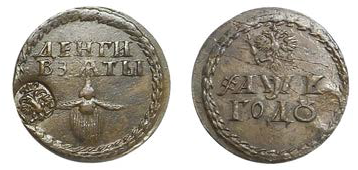
To read the complete article, see:
Barber calls for tax on beards
(www.worcesternews.co.uk/news/14489079.Barber_calls_for_tax_on_beards/)
To read earlier E-Sylum articles on beard tax tokens, see:
QUERY: RUSSIAN BEARD TAX TOKEN COUNTERSTAMPS
(www.coinbooks.org/esylum_v15n46a19.html)
MORE ON THE RUSSIAN BEARD TOKENS (www.coinbooks.org/esylum_v15n47a14.html)
FEATURED WEB PAGE: NEW JERSEY COPPERS
This week's Featured Web page is an Introduction to New Jersey Coppers 1786-1790 from the University of Notre Dame web site.On June 1, 1786, the New Jersey legislature authorized Walter Mould, Thomas Goadsby, and Albion Cox to mint three million copper coins at a weight of 150 grains each over a two-year period in return for a ten percent royalty to the state and the posting of a £10,000 surety bond. The coppers were to circulate at fifteen to the shilling and were to be produced within New Jersey. The design of the coins was not resolved, the legislation simply stated they were to have "Marks and Inscriptions as shall be directed by the Justices of the Supreme Court, or any one of them."
The obverse of the copper displayed a plow beneath a horse head facing right with the legend NOVA CÆSAREA (as on the state coat of arms) and the date. The use of "CÆSAREA" is based on the ancient classical name for the Island of Jersey in the English Channel. In Roman times this island was called Caesar's Island (insula Caesarea) so when latinizing the state name, the word "Jersey" was transformed to "Caesarea." The 1688 indenture issued by Charles II called the colony "Nova Caesarea, of New Jersey." The reverse of the coin depicted an American shield that is similar to one used on some of the confederation patterns along with the national motto as the legend, E PLURIBUS UNUM (One from many). New Jersey coppers were the first coins to bear the national motto.

www.coins.nd.edu/ColCoin/ColCoinIntros/NJ-Copper.intro.html


